Cats
Can Cats Eat Mushroom Soup Safely?
Beware of feeding cats mushroom soup as it may contain harmful ingredients; discover why it's not safe for feline consumption.
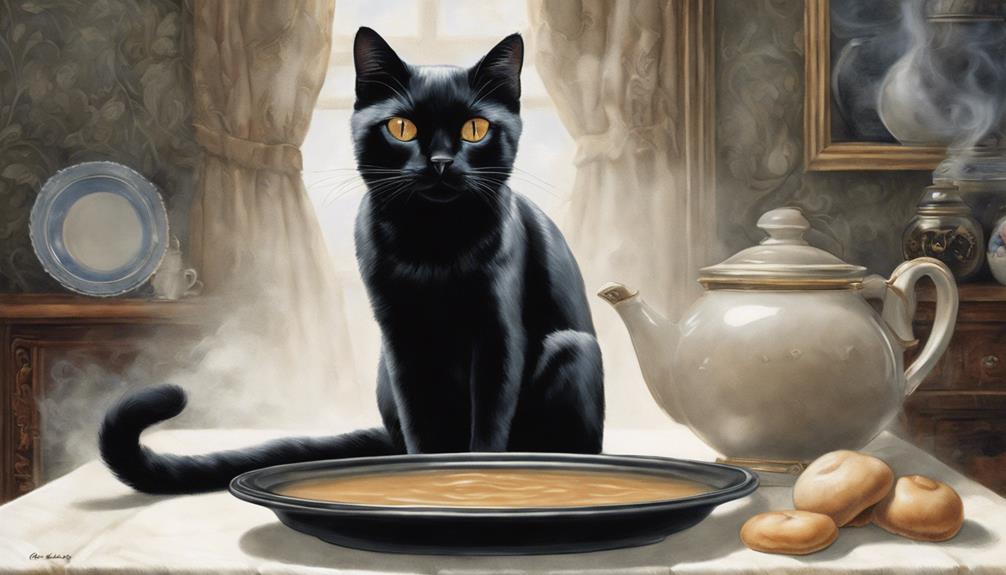
Cats shouldn't have mushroom soup. It contains harmful ingredients like onions, garlic, and high salt levels. The soup may lack essential nutrients for cats' health. Stick to cat-formulated foods. Unsuitable foods can cause health complications. If interested, we have more insights on cats and mushrooms.
Key Takeaways
- Mushroom soup can contain harmful ingredients like onions and garlic, unsuitable for cats' digestive systems.
- High salt levels in mushroom soup are detrimental to cats' health.
- Cats should stick to specially formulated cat food to meet their nutritional needs.
- Feeding cats mushroom soup can lead to health issues due to ingredients that cats cannot digest.
- Consult a vet before offering any mushrooms or mushroom soup to cats to prevent potential health risks.
Cats Digestive System and Mushrooms
When it comes to cats and mushrooms, their digestive system struggles to effectively break down certain compounds found in these fungi. Cats are carnivores by nature, and their digestive systems aren't designed to handle plant materials like mushrooms efficiently. This means that when cats eat mushrooms, especially those with tough cell walls or indigestible fibers, it can lead to digestive issues. Even certain cooked mushrooms may still retain harmful substances that can be challenging for cats to process.
It's important to note that while some mushrooms are safe for cats to consume, many varieties can be toxic. For instance, mushroom soup, a common human dish, may contain ingredients that are harmful to cats. Consulting a veterinarian before offering any human food, including mushroom soup, to your feline friend is essential for their health and safety. By understanding how cats' digestive systems interact with mushrooms, we can make informed choices to keep our beloved pets safe and healthy.
Toxicity of Mushrooms for Cats
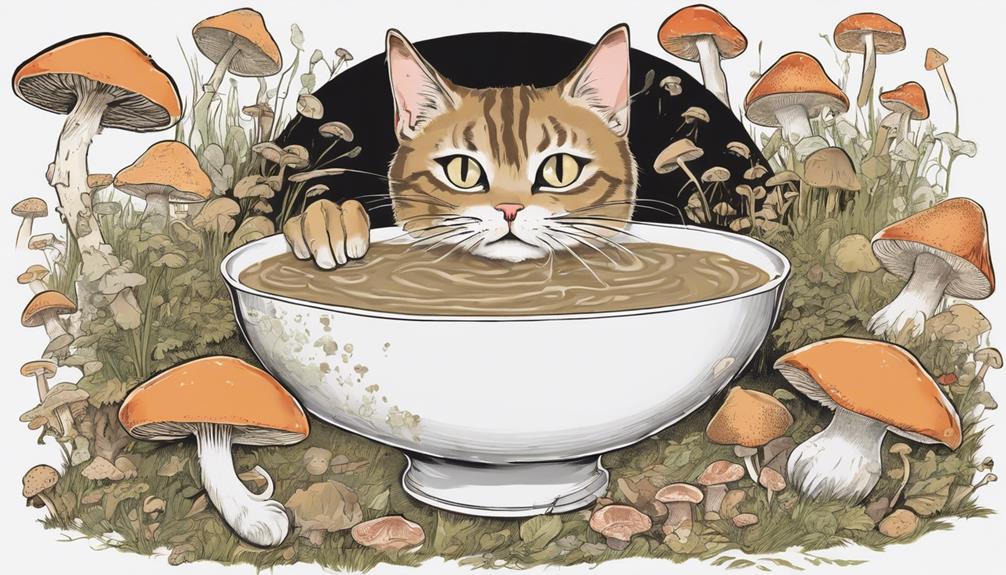
In considering the toxicity of mushrooms for cats, it's vital to be aware of the potential dangers certain fungi pose to feline health. Some mushrooms can be highly harmful to cats and should be avoided at all costs. Here are three essential points to keep in mind:
- Toxic Mushrooms: Certain varieties of mushrooms contain harmful toxins that can be extremely perilous if ingested by cats. These toxic mushrooms can lead to severe health issues and even be fatal to our feline companions.
- Gastrointestinal Upset: Consumption of toxic mushrooms can result in gastrointestinal disturbance in cats. This can manifest as symptoms like vomiting, diarrhea, and abdominal pain, causing discomfort and distress to our beloved pets.
- Avoid Feeding: To safeguard the well-being of our cats, it's crucial to steer clear of feeding them any mushrooms, especially those of unknown origin or species. Prevention is key in ensuring our furry friends stay healthy and happy.
Risks of Mushroom Soup for Cats
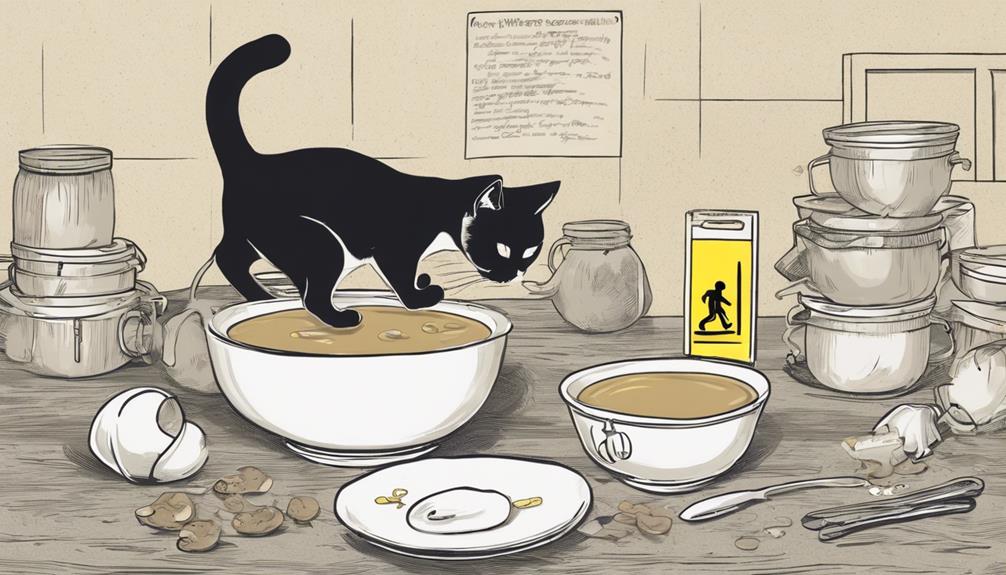
Cats should steer clear of mushroom soup due to the possible risks it poses to their health, including harmful ingredients like onions and garlic. These components can be poisonous to cats and may lead to various health issues. Additionally, the high levels of salt commonly found in mushroom soup can also be detrimental to a cat's well-being. Moreover, the ingredients in mushroom soup may not align with a cat's specific dietary needs, making it an unsuitable choice for our feline companions.
When cats eat mushrooms, they're exposed to toxic compounds found in certain varieties that can be harmful to their health. To guarantee the safety and health of our cats, it's essential to feed them specially formulated cat food that meets all their nutritional requirements. By avoiding mushroom soup and sticking to a diet tailored to their needs, we can help prevent any potential health issues that may arise from consuming unsuitable foods. Remember, our cats rely on us to make the best choices for their well-being.
Symptoms of Mushroom Poisoning in Cats
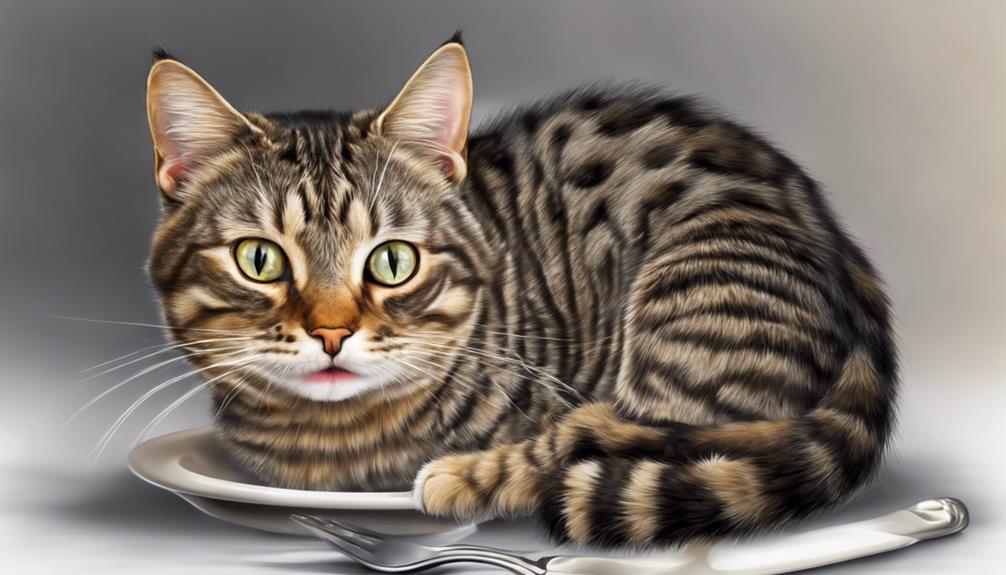
Experiencing gastrointestinal upset, neurological symptoms, jaundice, and changes in heart rate are indicators of mushroom poisoning in cats. When it comes to mushroom toxicity, our feline friends can show various signs that may signal danger.
Here are three key symptoms to watch out for:
- Gastrointestinal Upset: If your cat starts vomiting or having diarrhea after ingesting mushrooms, it could be a sign of poisoning. Keep a close eye on their bathroom habits and appetite changes.
- Neurological Symptoms: Excessive salivation, seizures, or even coma can be alarming neurological signs of mushroom poisoning. Any unusual behavior in your cat should prompt a visit to the vet.
- Jaundice: The yellowing of the skin and eyes, known as jaundice, is a serious symptom of severe mushroom poisoning. This visible change indicates a critical condition that requires immediate medical attention. Pay attention to any color changes in your cat's appearance, as it could be a red flag for their health.
Safe Mushroom Varieties for Cats

When considering safe mushroom varieties for cats, it's vital to stick to store-bought options like white button, cremini, or shiitake. These cultivated mushrooms are secure choices for our feline friends, providing a tasty treat when served in moderation. It's crucial to steer clear of wild mushrooms, as they can be harmful to cats and pose serious health risks.
By offering safe mushrooms like white button, cremini, or shiitake to our cats, we can guarantee that they enjoy a variety of flavors in their diet without compromising their well-being. Remember to serve these mushrooms unseasoned and cooked before offering them to your cat to avoid any potential digestive issues. While mushrooms can be a delightful addition to your cat's food repertoire, they should only be given occasionally and not as a primary source of nutrition.
Choosing the right mushrooms for your cat's meals ensures they can enjoy a safe and tasty treat without any worries about potential toxicity.
Cooking Mushrooms for Cats

Cooking mushrooms for cats is essential for their safety and health.
By properly cooking mushrooms, we can make them easier to digest and eliminate potential harmful substances found in raw mushrooms.
Ensuring thorough cooking is vital to minimize any risks associated with feeding mushrooms to cats.
Mushroom Soup Risks
Mushroom soup poses potential risks to cats due to the inclusion of ingredients like onions and garlic, which can be harmful to their health. Here are three reasons why mushroom soup may not be suitable for our feline friends:
- Toxic Ingredients: Onions and garlic, commonly found in mushroom soup, contain harmful substances that can be toxic to cats.
- High Salt Content: The high salt content in mushroom soup can be detrimental to a cat's health, potentially leading to issues like dehydration or kidney problems.
- Nutritional Deficiency: Cats have specific dietary requirements for essential nutrients that may not be adequately met by consuming mushroom soup.
As cat parents, it's important to be mindful of what we feed our furry companions to guarantee their well-being and health.
Safe Mushroom Preparation
While mushroom soup may pose risks to cats, safe mushroom preparation involves using specific store-bought varieties like white button, cremini, or shiitake to guarantee feline safety. It's important to make sure the mushrooms are unseasoned and cooked thoroughly before serving them to your furry friend.
By opting for cultivated varieties and steering clear of toxic wild mushrooms, you can create a safe and tasty treat for your cat. Remember that store-bought mushrooms should be given in moderation and as an occasional indulgence rather than a regular part of their diet.
When prepared thoughtfully with your cat's well-being in mind, properly cooked mushrooms can be a delightful addition to their meals.
Mushroom Allergies in Cats
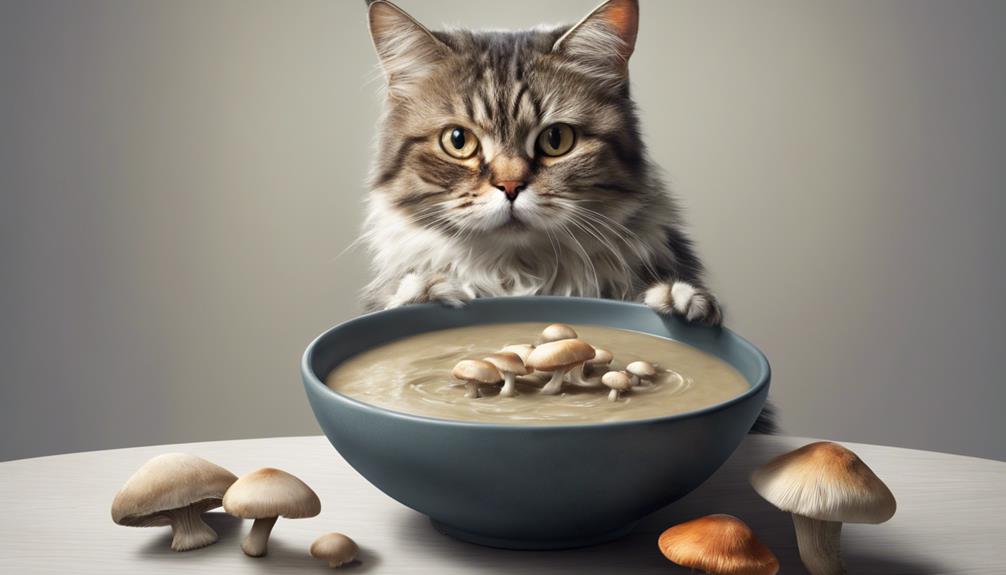
Although relatively uncommon, cats can develop allergies to mushrooms, which can result in a range of symptoms affecting their health and well-being. When it comes to mushroom allergies in cats, it's vital to understand the following:
- Symptoms: Allergic reactions to mushrooms in cats can present with symptoms such as itching, skin irritation, gastrointestinal issues, sneezing, coughing, or watery eyes.
- Severity: The severity of allergic reactions to mushrooms in cats can vary, ranging from mild discomfort to more severe complications that may impact their overall well-being.
- Veterinary Attention: If you suspect your cat is experiencing mushroom allergy symptoms, it's important to seek veterinary attention promptly. Your vet can provide guidance on managing the allergy and ensuring your cat's health and comfort.
Being aware of the potential for mushroom allergies in cats and understanding the associated symptoms and severity can help you take proactive steps to keep your feline friend safe and healthy.
Identifying Toxic Mushrooms
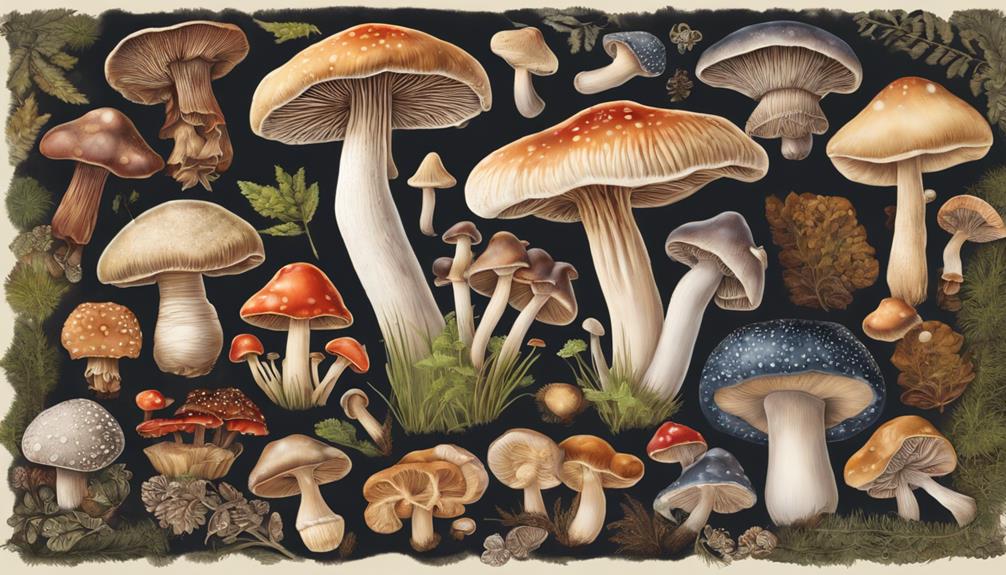
Identifying toxic mushrooms is essential to safeguarding our feline friends. Some harmful mushrooms have distinct characteristics that set them apart from safe varieties.
Knowing how to differentiate between toxic and safe mushrooms can prevent accidental ingestion by cats.
Toxic Mushroom Identification
Spotting toxic mushrooms that are harmful to cats requires sharp observation skills and knowledge of specific identifying characteristics. When it comes to spotting toxic mushrooms, here are three key points to keep in mind:
- Species Knowledge: Get familiar with toxic mushrooms like Amanita, Galerina, and Gyromitra that can be harmful to cats.
- Physical Characteristics: Pay attention to features like color, shape, and texture, which can help distinguish toxic mushrooms from safe ones.
- Consultation: If uncertain, seek guidance from experts or use reliable resources to guarantee accurate identification.
Harmful Mushroom Characteristics
As specialists in toxic mushroom identification, we must remain vigilant in recognizing key characteristics that differentiate harmful varieties from safe ones.
Toxic mushrooms contain compounds like amatoxins, muscarine, and gyromitrin, which pose serious risks to our feline friends. Identifying toxic mushrooms requires expertise due to the similarities between safe and poisonous varieties. Look for distinguishing features such as a ring on the stem, spore color, cap shape, and gill attachment.
Poisonous mushrooms can lead to gastrointestinal distress, liver damage, kidney failure, or neurological symptoms in cats. To keep our furry companions safe, it's crucial to prevent accidental ingestion by ensuring they don't have access to areas where toxic mushrooms may grow.
Stay informed and keep a watchful eye to protect our beloved pets from potential harm.
Safe Mushroom Alternatives
To ensure the safety of our feline companions, understanding the differences between safe mushroom alternatives like white button, cremini, and shiitake varieties and toxic mushrooms is essential. Here are three vital points to help you identify toxic substances and choose non-toxic mushrooms for your cat's well-being:
- Safe Mushroom Alternatives: White button, cremini, and shiitake mushrooms are safe options for cats when cooked properly.
- Types of Mushrooms to Avoid: Toxic mushrooms such as Amanita, Galerina, Gyromitra, Inocybe, Conocybe, Clitocybe, and Cortinarius species should be avoided.
- Identifying Toxic Substances: Knowing how to recognize toxic mushrooms is crucial in preventing poisoning incidents in cats.
Treatment for Mushroom Poisoning

Treatment for mushroom poisoning in cats typically involves inducing vomiting to expel toxins from the system. If a cat ingests toxic mushrooms, it's important to act promptly. By causing the cat to vomit, we can help rid their body of harmful substances.
In more severe cases, activated charcoal may be given to absorb any leftover toxins in the stomach, aiding in the detoxification process. Additionally, providing supportive care such as intravenous fluids and medications to address symptoms like seizures or liver damage is essential for the cat's recovery.
Monitoring the cat's vital signs and blood work is crucial to evaluate their progress and response to treatment accurately. Remember, quick veterinary intervention significantly enhances the likelihood of a successful outcome when dealing with mushroom poisoning in cats. So, if you suspect your feline friend has consumed toxic mushrooms, don't hesitate to seek immediate professional help to safeguard their well-being.
Integrating Mushrooms in Cat Diet
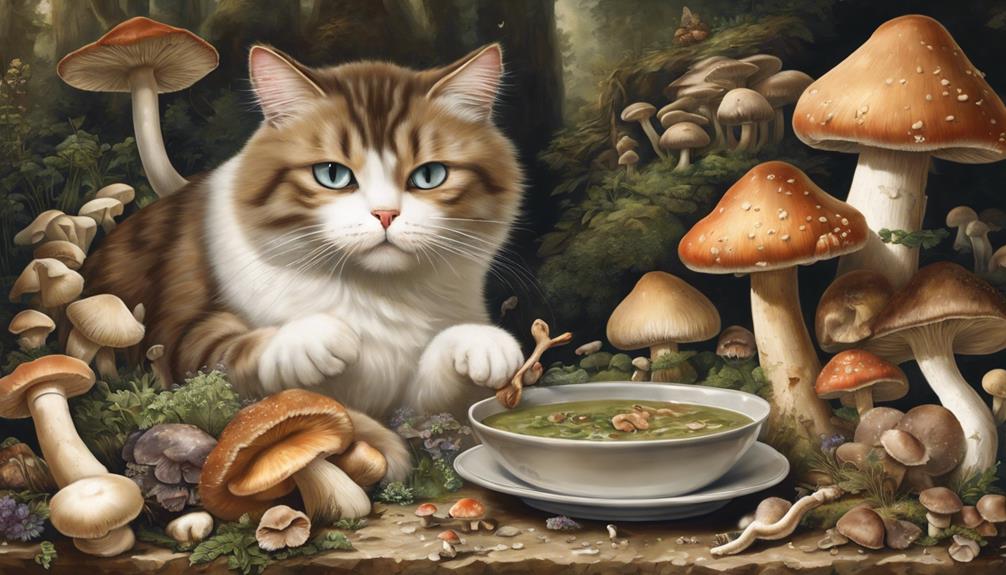
When contemplating incorporating mushrooms into a cat's diet, it's vital to weigh the benefits and risks. While mushrooms can provide certain nutrients advantageous to cats, such as protein and fiber, some varieties can be toxic to them.
It's imperative to carefully research which mushrooms are safe for feline consumption and consult a veterinarian before introducing any new food to your cat's diet.
Mushroom Benefits for Cats
Have you ever considered integrating mushrooms into your cat's diet to provide minor nutritional benefits and a savory flavor they may enjoy? Here are three reasons why mushrooms can be a positive addition to your feline friend's diet:
- Nutritional Boost: Mushrooms offer vitamins and antioxidants that can support your cat's overall health and well-being.
- Savory Delight: The glutamate found in mushrooms adds a delicious umami flavor that some cats find irresistible.
- Safe Option: Culinary mushrooms like button, cremini, and shiitake are safe for cats when cooked properly, making them a suitable occasional treat for your pet's enjoyment. Remember, moderation is key, and mushrooms shouldn't replace essential nutrients in your cat's balanced diet.
Risks of Mushroom Consumption
Integrating mushrooms into a cat's diet requires careful consideration due to the potential risks associated with mushroom consumption for felines. Mushroom poisoning in cats can lead to severe health issues, causing gastrointestinal upset and even being toxic to cats. It's vital to avoid feeding mushrooms to your furry friend to prevent any potential harm.
Cats have sensitive digestive systems, and certain types of mushrooms can be particularly harmful to them. To guarantee your cat's well-being, it's best to stick to their regular balanced diet that meets all their nutritional requirements. Consulting with a veterinarian before introducing any new food, including mushrooms, is essential to keep your cat safe and healthy.
Mushroom Soup and Cat Health
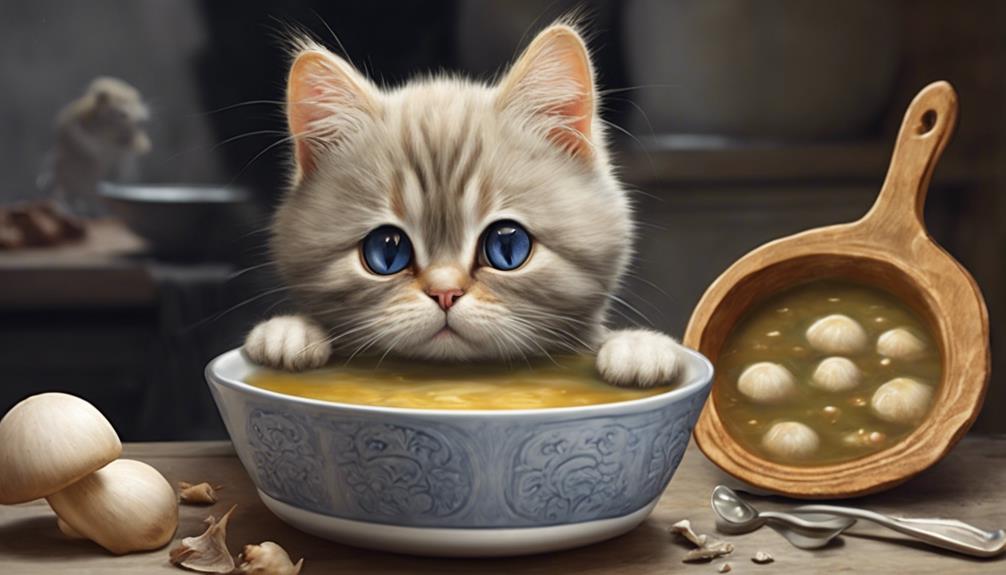
Discussing the implications of mushroom soup on a cat's health reveals potential risks due to harmful ingredients such as onions and garlic. While mushroom soup might seem like a cozy treat, it can be unsuitable for cats and pose potential health risks.
Here are three reasons why mushroom soup is harmful to cats:
- Toxic Ingredients: Onions and garlic, commonly found in mushroom soup, are toxic to cats and can lead to serious health issues such as damage to their red blood cells.
- High Salt Content: Mushroom soup often contains high levels of salt, which can be harmful to a cat's health, leading to issues like dehydration and kidney problems.
- Mismatched Nutritional Needs: The ingredients in mushroom soup don't align with a cat's specific dietary requirements. Cats need a balanced diet tailored to their carnivorous nature, and mushroom soup doesn't provide the necessary nutrients.
Considering these factors, it's best to avoid feeding mushroom soup to your feline friend to safeguard their well-being and health.
Mushroom Risks in Cat Foods
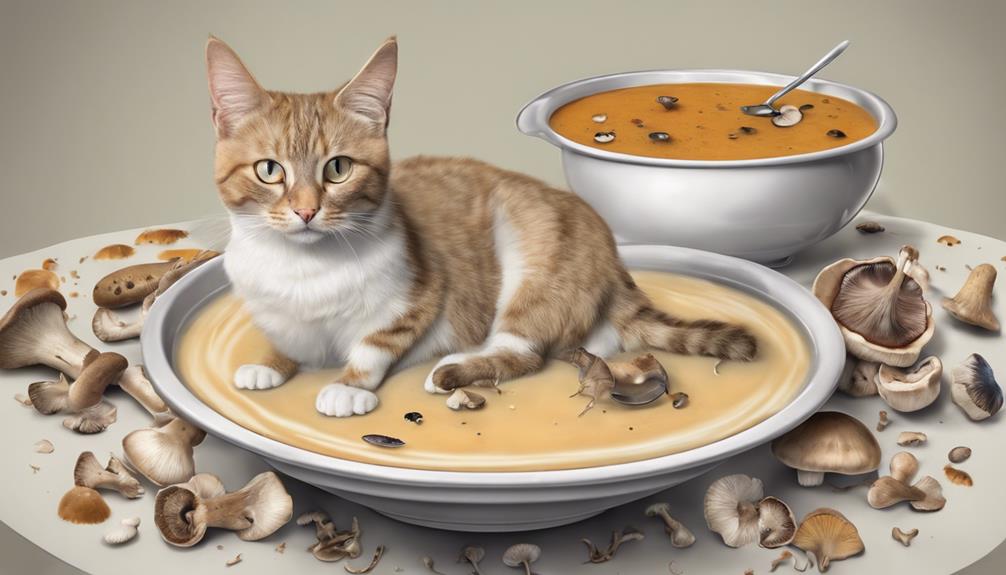
Mushroom risks in cat foods extend beyond mushroom soup, potentially introducing harmful ingredients that can adversely affect a cat's health. When considering the inclusion of mushrooms in a cat's diet, it's important to be aware of the potential health issues that may arise. Mushroom soup often contains ingredients like onions and garlic, which are harmful for cats and can lead to various health issues. Additionally, the high levels of salt commonly found in mushroom soup are not suitable for a cat's dietary requirements. Cats have specific dietary needs that must be met to maintain their well-being, and mushroom soup may not align with these needs. It is essential to carefully evaluate the ingredients in any cat food, including mushroom-based products, to make sure they are safe and beneficial for your feline friend.
| Mushroom Risks in Cat Foods | |
|---|---|
| Onions and Garlic | Harmful to Cats |
| High Salt Levels | Health Issues in Cats |
| Not Meeting Dietary Needs | Potential Harm |
| Specific Dietary Requirements | Cat Well-being |
| Ingredient Evaluation | Ensuring Safety |
Mushroom Soup Vs. Raw Mushrooms

When comparing mushroom soup with raw mushrooms in relation to feline nutrition, it's important to take into account the potential impact on a cat's health and dietary requirements.
- Mushroom soup often contains ingredients like onions and garlic that are harmful to cats, causing digestive issues and potential toxicity.
- Raw mushrooms, when cooked in soup, may lose some of their nutritional value for cats, diminishing the benefits they could provide in their natural state.
- High levels of salt in mushroom soup can be harmful to a cat's health, leading to dehydration and potential kidney problems if consumed regularly.
Considering these factors, it becomes evident that serving mushroom soup to cats isn't advisable due to the risks involved. It's essential to prioritize your feline companion's well-being by opting for safer and more suitable food options that align with their specific dietary needs.
Cat-Friendly Mushroom Serving Sizes

Cat owners should be mindful of appropriate serving sizes when incorporating mushrooms into their feline companion's diet. While mushrooms themselves can be safe for cats in moderation, it's essential to take into account harmful ingredients commonly found in dishes like mushroom soup, such as onions, garlic, and excessive salt. Cats have specific dietary needs that are best met with cat-formulated food, ensuring they receive the essential nutrients for their well-being. Mushroom soup, lacking balance and potentially harmful components, may lead to digestive issues if consumed by cats.
When determining cat-friendly serving sizes of mushrooms, always consult a veterinarian. They can offer tailored advice based on your cat's individual dietary requirements. Remember, what's suitable for humans may not align with our feline friends' needs. Ensuring the right portions and types of food are crucial for keeping your cat healthy and happy. By prioritizing your cat's specific dietary needs and seeking professional guidance, you can make informed decisions about incorporating mushrooms into their diet safely.
Mushroom Consumption Guidelines for Cats

When contemplating mushroom consumption guidelines for cats, it's essential to focus on safe mushroom types and be aware of potential risks. Certain mushrooms can be toxic to cats and may cause health issues.
Always prioritize your cat's well-being by consulting with a veterinarian before introducing any new food items into their diet.
Safe Mushroom Types
Selecting the appropriate types of mushrooms is essential when contemplating including them in a cat's diet. When deciding on safe mushroom types for your feline friend, consider the following:
- Store-Bought Varieties: White button, cremini, and shiitake mushrooms are safe options for cats.
- Cultivated Mushrooms: These can be given to cats in moderation as an occasional treat.
- Avoid Wild Mushrooms: Due to the risk of toxicity, it's important to steer clear of wild mushrooms when feeding your cat.
Potential Risks for Cats
Considering the potential risks associated with mushroom consumption for cats, it's important to be mindful of their dietary requirements and the ingredients in foods like mushroom soup before offering it to them. Cats, as obligate carnivores, have specific nutritional needs that may not be met by mushrooms. Certain mushrooms can cause symptoms of toxicity in cats, ranging from gastrointestinal upset to more severe signs like tremors or seizures.
Additionally, mushroom soup often contains ingredients like onions and garlic, which are known to be harmful to cats. The high salt content in mushroom soup can also be detrimental to feline health. To guarantee the well-being of your furry friend, it's best to steer clear of offering mushroom soup and consult a veterinarian for guidance on a suitable diet.
Frequently Asked Questions
Can Cats Eat Mushroom Broth?
We recommend avoiding feeding cats mushroom broth due to potential toxicity from ingredients like onions or garlic and the high sodium levels. Cats, being carnivores, may not find mushroom broth appealing. Prioritize their health; consult a vet first.
What Are the Symptoms of Mushroom Poisoning in Cats?
Experiencing mushroom poisoning in cats reveals distressing symptoms like gastrointestinal upset, seizures, and changes in behavior. If your feline companion consumed mushroom soup, would they exhibit signs of toxicity like vomiting or jaundice?
Can You Give Cats Canned Soup?
We don't recommend giving cats canned soup. It's high in salt and may contain toxic ingredients like onions and garlic. Cats have specific dietary needs best met with balanced cat food. Consult a vet beforehand.
Can Cats Eat Mushroom Stems?
We enjoy giving our cats occasional treats like mushroom stems. They provide fiber and nutrients. Cook them well. Watch for any adverse reactions and seek vet advice if needed. Our cats' well-being is our top priority.
Conclusion
To sum up, while mushrooms can be a tasty addition to our meals, they can pose risks to our feline friends. It's important to be cautious and avoid feeding cats mushroom soup or any raw mushrooms.
Remember, only 1-2% of mushrooms are safe for cats to consume, so always consult with your veterinarian before offering any new foods to your furry companions. Prioritizing their health and safety is key in ensuring a happy and healthy life for your beloved pets.
Paul’s love for animals knows no bounds. As a dedicated writer and animal lover, Paul brings a unique perspective to our team. His firsthand experiences with various animals enrich our content and provide valuable insights into their behavior and needs. Whether he’s sharing tips for pet care or shedding light on pressing conservation issues, Paul’s passion for animals shines through in everything he does.
Cats
Common Reasons for Swollen Cat Lower Lips
Perplexed by your cat's swollen lower lips? Explore potential causes, from allergies to dental issues, for optimal feline health.
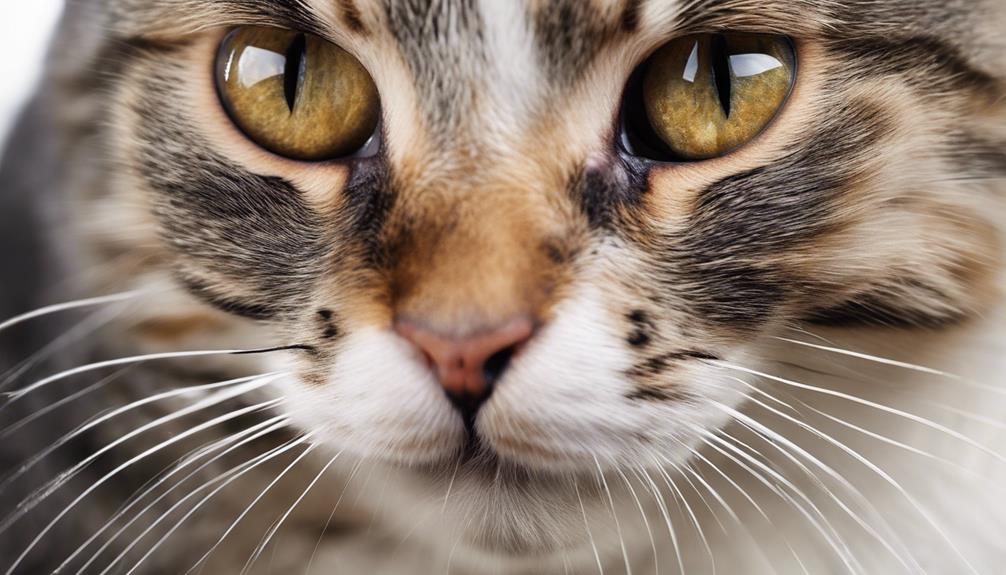
If your cat's lower lips are swollen, it could be due to a range of reasons. Allergic reactions may cause redness and itching, requiring prompt veterinary attention. Dental issues like gum inflammation and tartar buildup can lead to swelling, with professional dental care recommended. Feline acne presents as swollen lips, treated with gentle cleansing and antiseptics. Tumors, infections, and trauma can also result in lip swelling, emphasizing the need for early detection and treatment. Other possible causes include eosinophilic granuloma complex, food allergies, and periodontal disease. Understanding the root cause is crucial for your cat's well-being.
Key Takeaways
- Allergic reactions can cause redness, itching, and inflammation in a cat's lower lip.
- Dental issues like decay and gum inflammation may lead to lip swelling.
- Feline acne, characterized by blackheads and red bumps, can cause swollen lower lips.
- Eosinophilic granuloma complex presents as raised, ulcerative lesions on the bottom lip.
- Tumors, infections, trauma, and rodent ulcers are common causes of swelling in a cat's lower lip.
Allergic Reactions
When encountering allergic reactions, a cat's lower lip may swell due to hypersensitivity to various triggers. Recognizing the signs of an allergic reaction in your feline companion is vital. Symptoms like redness, itching, and swelling in the cat's lower lip area indicate a possible allergic response.
This localized inflammation can be caused by allergens such as specific food ingredients, environmental factors, or even insect bites. If you notice your cat experiencing discomfort or a swollen lower lip, immediate veterinary attention is essential. A vet can identify the allergen responsible and recommend appropriate treatment options.
These may include allergy testing to pinpoint the trigger, strategies to avoid the allergen in the future, and medications to alleviate swelling and discomfort. By addressing allergic reactions promptly and effectively, you can help your cat find relief and prevent future episodes of a swollen lower lip.
Dental Issues
When it comes to our cats' oral health, tooth decay impacts not only their teeth but also their lower lip health.
Gum inflammation can be directly linked to dental issues, leading to swelling in the lower lip area.
Additionally, tartar buildup from poor dental hygiene can have negative effects on our feline friends' lower lips.
Tooth Decay Impact
Tooth decay in cats plays a significant role in gum inflammation, infections, and swelling in the lower lip area. When dental disease strikes, it can lead to discomfort for our feline friends. Signs like bad breath, drooling, and reluctance to eat may indicate trouble brewing. If left unchecked, tooth decay can progress to abscess formation, causing swelling and pain in the lower lip.
In severe cases, this swelling can extend beyond the lip, affecting overall health. Seeking timely dental care is essential to address these issues. Professional cleaning and treatment for tooth decay not only help alleviate lower lip swelling but also make sure our cats maintain good oral health.
Gum Inflammation Connection
Swollen lower lips in cats can often be attributed to gum inflammation stemming from untreated dental issues, highlighting the essential connection between oral health and lip swelling. When it comes to dental issues and lower lip swelling in cats, several key points are important to understand:
- Periodontal disease is a common cause of gum inflammation leading to lower lip swelling.
- Untreated dental problems like infections or abscesses can result in discomfort and lip swelling.
- Foul breath may indicate underlying dental issues contributing to lower lip swelling.
- Difficulty eating could be a sign of gum inflammation affecting the cat's lower lip.
- Regular dental check-ups and good oral hygiene practices are critical in preventing gum inflammation and subsequent lower lip swelling in cats.
Tartar Buildup Effects
Excessive tartar buildup on a cat's teeth can lead to gum inflammation, infection, and swelling in the lower lip area. When tartar accumulates, it provides a breeding ground for bacteria that can trigger periodontal disease, causing redness, swelling, and discomfort in your cat's lower lip.
If left untreated, this tartar buildup can progress to more severe dental issues, worsening the swelling in the lower lip. To prevent these problems, it's important to prioritize regular dental care for your feline friend.
Professional cleanings and consistent at-home dental care can help keep tartar at bay, reducing the risk of lower lip swelling and improving your cat's overall oral health. Stay proactive in addressing tartar buildup to safeguard your cat's comfort and well-being.
Feline Acne

Feline acne in cats is a common skin condition that can lead to swollen lower lips, blackheads, and red bumps on the chin and lips. It occurs when hair follicles and oil glands become blocked, resulting in inflammation and discomfort for our feline friends.
Treatment options for feline acne include gentle cleansing, topical antiseptics, and antibiotics prescribed by a veterinarian to help alleviate symptoms and maintain skin health.
Causes of Feline Acne
Causes of feline acne commonly stem from factors such as stress, poor grooming habits, plastic food dishes, and skin allergies. Here are some key points to contemplate:
- Stress: Cats can develop acne when feeling anxious or stressed, impacting their skin health.
- Poor Grooming Habits: Inadequate grooming can lead to the buildup of oils and dirt on the chin, contributing to acne.
- Plastic Food Dishes: Bacteria can thrive on plastic surfaces, potentially leading to skin issues like feline acne.
- Skin Allergies: Cats with allergies may have heightened skin sensitivities, making them more prone to developing acne.
- Hormonal Imbalances: Fluctuations in hormone levels can also play a role in the development of feline acne.
Treatment Options for Feline Acne
When addressing feline acne, the primary focus lies in implementing gentle cleansing techniques using cat-safe products to effectively treat the condition. Feline acne treatment typically involves using topical treatments such as benzoyl peroxide or chlorhexidine solutions to help clear up the affected areas on your cat's chin.
It's important to avoid harsh chemicals or human acne products, as they can irritate your cat's skin further. In severe cases, your vet may prescribe antibiotics or corticosteroids for feline acne treatment.
Regular monitoring and follow-up appointments with your vet are essential for successful management of feline acne. By using the right cat-safe products and following your vet's recommendations, you can help alleviate your cat's acne troubles and guarantee their skin stays healthy.
Eosinophilic Granuloma Complex

We often see raised, ulcerative lesions on the bottom lip in cats affected by eosinophilic granuloma complex. This condition can be distressing for both the cat and the owner, but understanding its causes is essential.
Here are some key points to keep in mind:
- Allergies play a significant role in triggering eosinophilic granuloma complex in cats.
- Genetic factors can predispose certain felines to developing this condition.
- Environmental triggers such as certain foods or substances may exacerbate the symptoms.
- Corticosteroids and immunosuppressive medications are commonly used in the treatment of eosinophilic granuloma complex.
- Regular follow-ups with the veterinarian, allergy management strategies, and environmental modifications are vital for effectively managing this condition in cats.
Tumors and Cancer
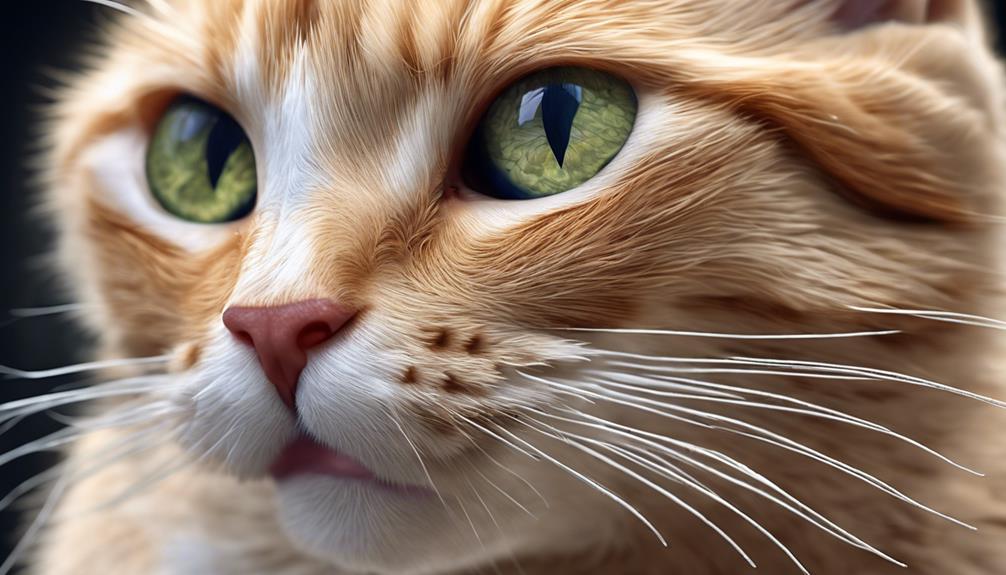
When it comes to cats, tumors and cancer can lead to swelling in the lower lip area. These abnormal cell growths may appear as lumps, ulcers, or growths on the lip.
Seeking prompt veterinary care is vital for diagnosing and determining the appropriate treatment for your feline friend.
Tumor Types in Cats
Discussing tumor types in cats involves examining various growths that can affect the lower lip, such as squamous cell carcinoma, fibrosarcoma, and melanoma. When it comes to tumors on a cat's lower lip, here are some important points to keep in mind:
- Squamous cell carcinoma is a common malignant tumor in cats, often linked to sun exposure.
- Fibrosarcoma is another type of cancerous growth that can develop in the connective tissue of the lower lip.
- Melanoma, while less common, can also affect a cat's lower lip and is related to melanin-producing cells.
- Early detection of these tumors is essential for effective treatment and management.
- Treatment options may include surgery, chemotherapy, or radiation therapy, tailored to the specific type and progression of the tumor.
Cancer Symptoms in Cats
Examining the symptoms of cancer in cats, particularly related to tumors, sheds light on the importance of early detection for effective treatment and improved outcomes.
Tumors in cats, especially those affecting the oral cavity, can manifest as lumps or growths on the lower lip, potentially indicating oral cancer. Watch out for symptoms like persistent swelling, bleeding, bad breath, and difficulty eating, as these could be signs of a more serious issue.
Remember, early detection is crucial when it comes to oral tumors in cats. If you notice any concerning symptoms, consult your veterinarian promptly for a thorough examination.
Treatment Options Available
Surgical removal may be necessary to address tumors or cancerous growths in a cat's lower lip and prevent further spread. When dealing with tumors or cancer affecting your cat's lower lip, here are some treatment options to contemplate:
- Chemotherapy or radiation therapy may be needed for aggressive or advanced cancer.
- Biopsy of the lip tissue is vital for determining the type of tumor.
- Regular follow-up appointments with a veterinary oncologist are essential for monitoring the cat's response to treatment.
- Palliative care and pain management strategies can enhance the quality of life for cats with advanced cancer.
- Consulting a Vet is pivotal to determine the best course of action for your feline friend.
Infections
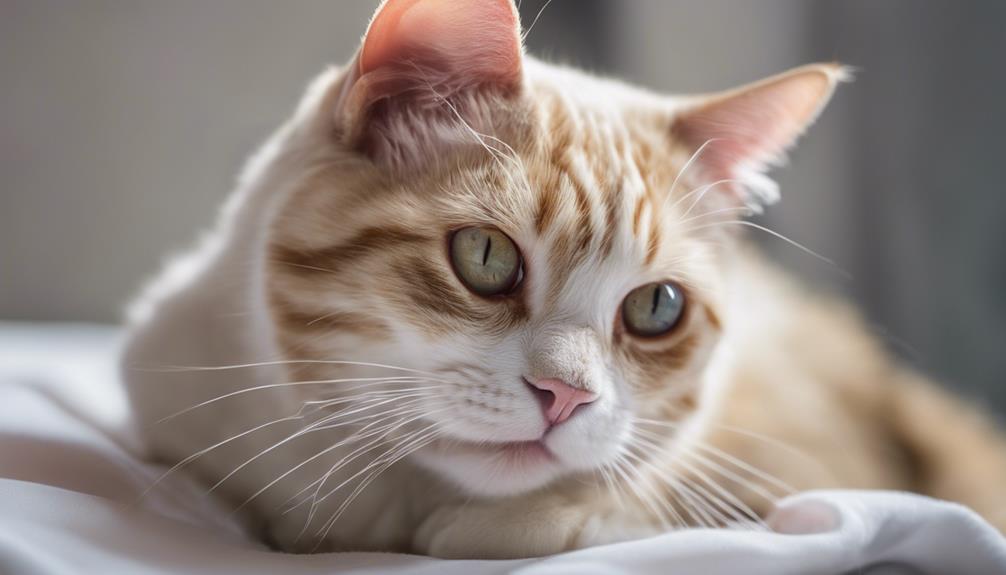
Infections present a common cause of swelling in a cat's lower lip, often characterized by redness and tenderness in the affected area. Bacterial or viral infections can lead to this swelling, with signs including warmth and discomfort. Infections in a cat's lower lip can stem from wounds, bites, or poor oral hygiene practices. It's vital to address these infections promptly to prevent complications and promote healing.
| Signs of Infection-Related Swelling |
|---|
| Redness |
| Warmth |
| Tenderness |
| Discomfort |
Treatment for infected lower lips typically involves antibiotics, wound care, and tackling the root cause of the infection. Seeking veterinary care promptly is essential for effective treatment and to safeguard the cat's well-being. By addressing infections early on, we can help our feline friends recover swiftly and comfortably.
Trauma
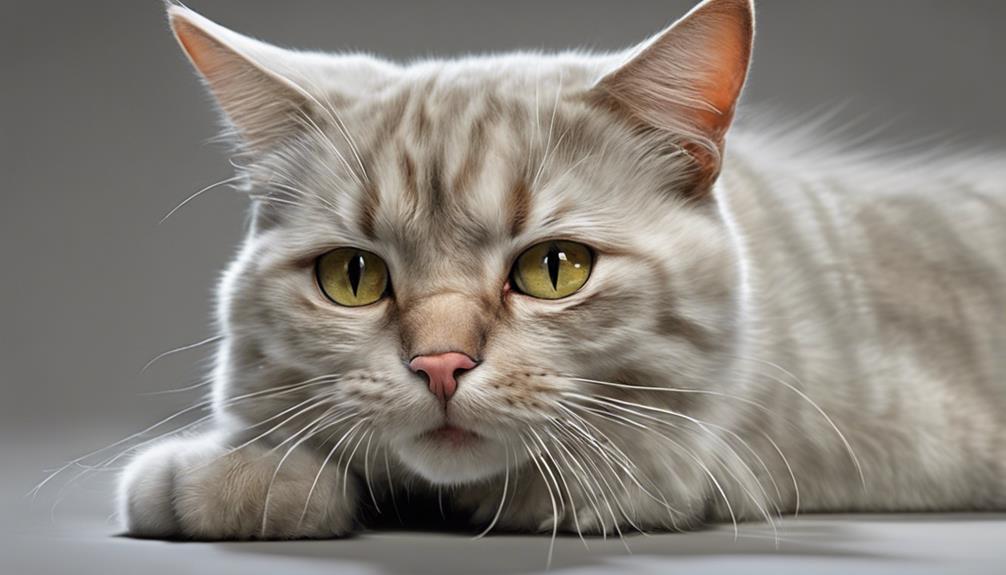
When a cat's lower lip undergoes trauma, it can be caused by various incidents such as fights or accidents. These injuries can lead to swelling, making it important to recognize signs like pain, redness, and eating difficulties.
Seeking prompt veterinary care is vital to properly address and manage any traumatic wounds in the lower lip.
Injury Causes Lip Swelling
In cases of lip swelling in cats caused by injuries, it's important to promptly address the underlying trauma to ensure proper healing and prevent complications.
When dealing with injury-related lip swelling in cats, consider the following:
- Immediate veterinary attention is essential for proper assessment and treatment.
- Proper wound care is necessary to prevent infections and promote healing.
- Antibiotics may be needed to fight off potential infections.
- Pain management is vital for the cat's comfort during the healing process.
- Monitoring for any signs of complications such as increased swelling or discharge is significant.
Ensuring these steps are taken can aid in the cat's recovery and prevent any further issues from arising.
Bites Lead to Swelling
Cat bites can lead to swelling in the lower lip area as a result of traumatic encounters or fights with other cats. When a cat bites, it can cause inflammation, redness, and tenderness in the affected area. Bacterial infections from these bites can exacerbate the swelling, making it vital to seek immediate veterinary attention.
Addressing the swollen lower lips promptly is essential to prevent complications and guarantee proper treatment. Veterinarians may recommend antibiotics, cleaning the wound thoroughly, and managing any associated pain.
Rodent Ulcers
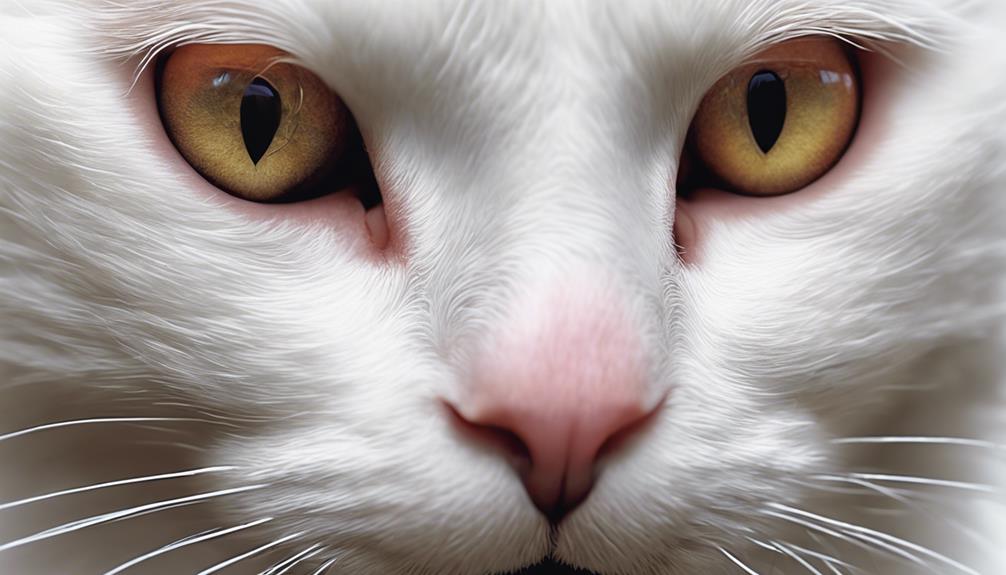
Upon examination, one may notice that rodent ulcers present as reddish, concave sores with crusty surfaces, typically situated near the upper lip and canine teeth in affected felines. Rodent ulcers are a manifestation of the eosinophilic granuloma complex in cats, impacting their skin and mucous membranes.
Here are some key points to understand about rodent ulcers:
- These ulcers can thicken over time and may develop raised borders.
- Changes in color and signs of tissue necrosis can be observed as the ulcers progress.
- Natural behaviors like licking can exacerbate rodent ulcers.
- Checking the inside of the cat's mouth may reveal ulcers there as well.
- Examining the underside of the lips can help in identifying rodent ulcers for accurate diagnosis and treatment.
Understanding these aspects can assist cat owners in recognizing and addressing rodent ulcers promptly to make sure their furry companions receive the necessary care.
Lip Granulomas
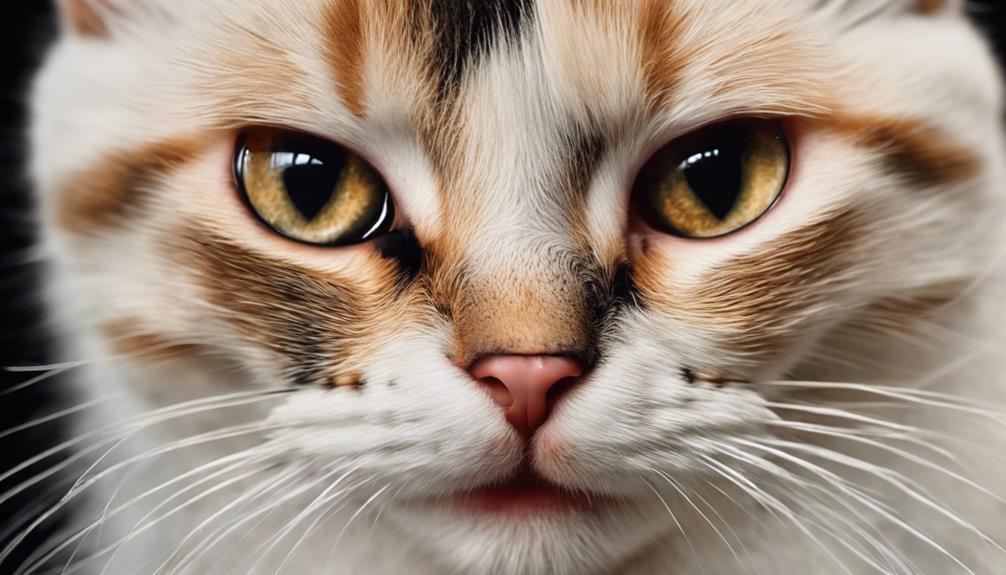
Examining the underside of the lips may also reveal the presence of lip granulomas in affected felines, which are raised, firm swellings often located on the bottom lip, particularly at the midline. These swollen areas can be part of the eosinophilic granuloma complex and may sometimes become ulcerative. Cats can develop hypersensitive reactions to allergens, food components, or environmental factors, triggering the formation of these lip granulomas.
Diagnosing lip granulomas involves a thorough dermatological examination, allergy testing, and treatment options like corticosteroids or immunosuppressive medications. Managing lip granulomas in cats requires ongoing care, including regular follow-ups, allergy management strategies, dietary adjustments, and environmental modifications to reduce triggers that may worsen the condition.
If you notice any swollen or raised areas on your cat's lower lip, seeking veterinary attention promptly is crucial for proper diagnosis and treatment of lip granulomas. Your furry companion's comfort and well-being are our top priority.
Periodontal Disease

Periodontal disease in felines can cause gum inflammation, infection, and swelling that may extend to the lower lip area. When dealing with periodontal disease, here are a few key points to keep in mind:
- Symptoms: Watch out for foul breath, difficulty eating, drooling, visible tartar, and pain in the lower lip region.
- Treatment: Prompt care is essential. Professional dental cleanings, tooth extractions if needed, antibiotics, and regular check-ups are necessary for managing the disease.
- Prevention: Maintaining good oral hygiene practices can help prevent periodontal disease and subsequent lower lip swelling in cats.
- Importance: Early detection and treatment are crucial to prevent severe health issues and discomfort that can affect a cat's behavior.
- Complications: If left untreated, periodontal disease can lead to complications like dental abscesses, which may worsen the swelling in the lower lip area.
Oral Tumors
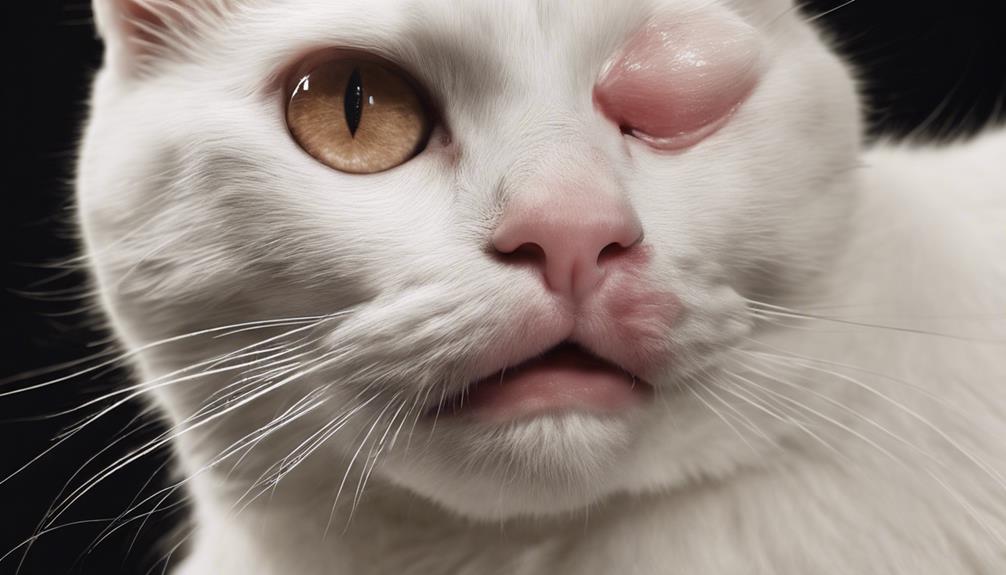
When addressing oral tumors in cats, it's important to consult with a veterinarian to determine the appropriate course of treatment based on the type and severity of the tumor.
Oral tumors can manifest as swollen lips in cats, causing discomfort and interfering with their ability to eat. Benign tumors may not always require immediate removal unless they result in noticeable swelling or affect your feline friend's well-being. However, cancerous tumors demand immediate attention.
In cases of cancerous growths on the lower lip, surgical removal might be necessary, accompanied by additional treatments to combat the cancer effectively. The swelling caused by oral tumors can greatly impact your cat's quality of life, making it crucial to address these issues promptly.
The sooner the tumor is identified and the treatment initiated, the better the chances of a positive outcome. Remember, consulting with a vet is essential in determining the best course of action for your cat's oral tumor.
Food Allergies
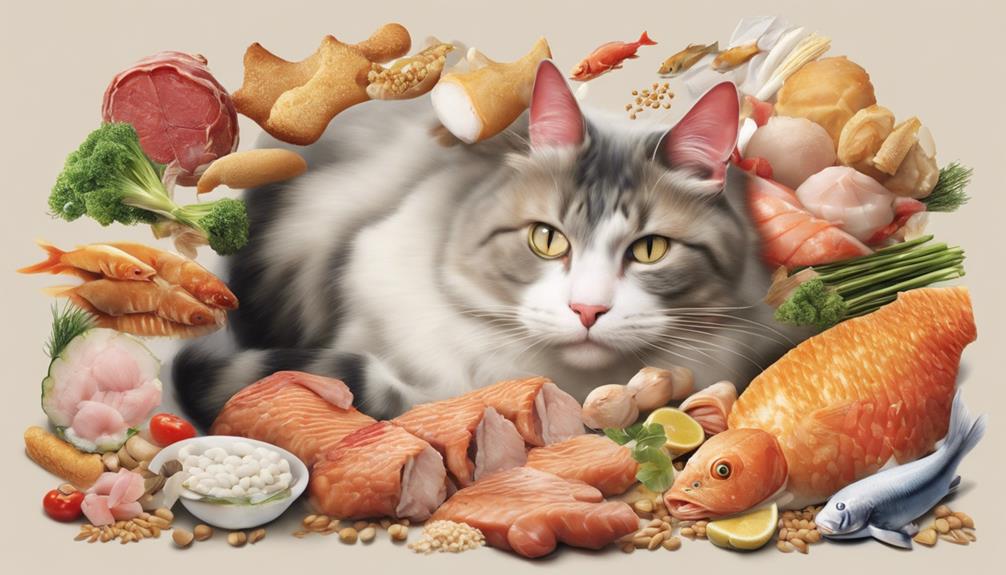
Food allergies can trigger sudden and severe swelling of a cat's lower lip following the ingestion of allergens. If your feline friend experiences lower lip swelling due to a food allergy, it's important to act promptly and seek immediate veterinary attention to guarantee their well-being. Here are some key points to keep in mind:
- Lower lip swelling from a food allergy can lead to discomfort, redness, and pain in the affected area.
- Immediate veterinary care is necessary to prevent potential complications that may arise from the swelling.
- Swelling caused by food allergies can escalate rapidly and even result in airway obstruction if not addressed promptly.
- Identifying and removing the specific food allergen triggering the reaction is essential in preventing future episodes of lower lip swelling in cats.
- Your vet can help determine the allergen through tests and advise on an appropriate diet to prevent further allergic reactions.
Inflammatory Conditions

In cats, swollen lower lips can be a result of various inflammatory conditions, including the eosinophilic granuloma complex. This complex can lead to inflammatory reactions that cause swelling in the lower lip area. Lip granulomas, a part of this complex, may manifest as firm, raised swellings on the bottom lip.
Allergic reactions to food, environmental factors, or allergens can also trigger inflammation in the lower lip region. Sometimes, inflammatory responses can occur without any visible allergens present, contributing to persistent swelling in the lower lip of cats.
It's important to promptly diagnose and treat these inflammatory conditions to effectively manage and alleviate the swollen lower lips in our feline companions. By addressing the underlying causes of inflammation, such as allergic reactions or conditions like the eosinophilic granuloma complex, we can help our cats find relief and guarantee their overall well-being.
Abscesses

Abscesses in cats commonly lead to swollen lower lips as a result of pus accumulation from infections. When dealing with abscesses, it's important to keep in mind the following:
- Signs of Infection: Keep an eye out for redness, warmth, and tenderness around the affected area, indicating a potential abscess.
- Causes of Abscesses: Abscesses can be triggered by bites, scratches, or puncture wounds that become infected, resulting in swollen lips in cats.
- Treatment Approach: Proper treatment involves draining the pus, cleaning the wound thoroughly, and administering antibiotics to combat the infection.
- Veterinary Care: Seeking prompt veterinary attention is essential to prevent complications and ensure the effective healing of abscess-related lip swelling in cats.
- Recovery Process: With the right treatment and care, most cats can recover well from abscesses, and the swelling in their lower lips should gradually subside.
Tooth Decay
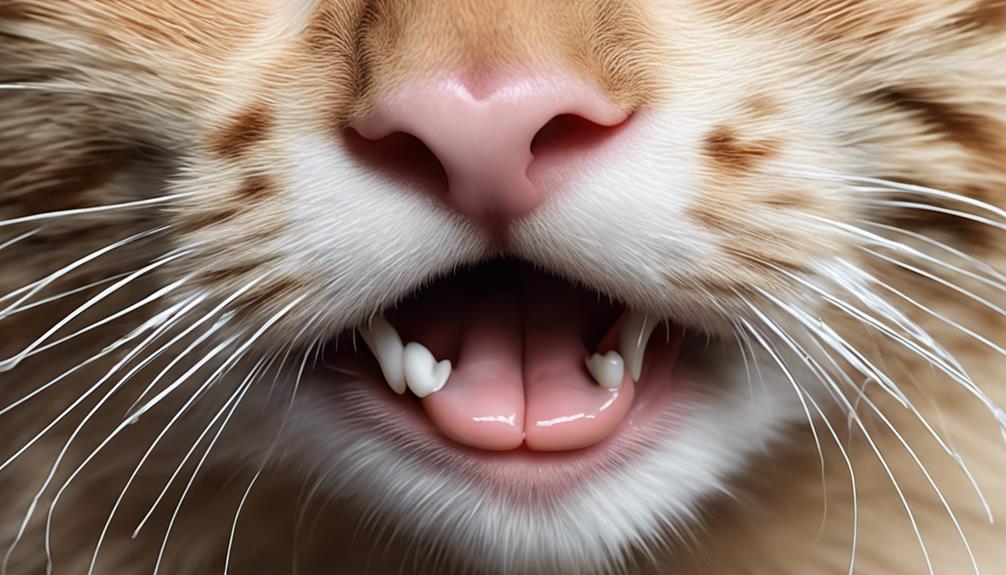
When addressing dental issues in cats, it's important to acknowledge that tooth decay can result in bacterial infections, inflammation, and swelling in the lower lip area.
Tooth decay in cats can lead to bacterial infections that may spread to the surrounding tissues, causing discomfort and swelling in the lower lip. If your feline friend is experiencing redness, pain, or difficulty eating, it could be due to tooth decay-related lip swelling.
It's essential to address dental issues promptly to prevent complications and further discomfort for your beloved pet. Treatment for tooth decay in cats may involve dental cleanings, extractions, antibiotics, and pain management to alleviate the symptoms and promote healing.
Regular dental check-ups and proper oral hygiene can help prevent tooth decay and its associated complications, keeping your cat's teeth and lips healthy. Remember, a healthy mouth leads to a happy cat!
Frequently Asked Questions
Why Is My Cat's Lower Lip Swollen?
We notice our cat's lower lip swollen. It could be due to feline acne, dental problems, or eosinophilic granuloma complex. Immediate vet care is crucial to diagnose the cause correctly and start the necessary treatment.
Should I Take My Cat to the Vet for a Swollen Lip?
Yes, we should take our cat to the vet for a swollen lip. It could be a sign of a serious health issue. Our furry friend deserves the best care, and a vet can provide the right treatment for a speedy recovery.
Why Does My Cats Mouth Look Puffy?
Our cat's mouth looks puffy due to various reasons like inflammation, infection, or allergies. Observing changes helps identify issues early. We consult a vet promptly for the best treatment plan. Monitoring our cat's health is essential.
Can Cat Allergies Cause Swollen Lips?
Yes, cat allergies can cause swollen lips. Allergic reactions trigger immune responses leading to inflammation and discomfort. Identifying allergens is paramount. Symptoms like redness, itching, or sneezing may accompany swollen lips. Managing allergies is essential for preventing recurrence.
Conclusion
To wrap up, swollen lower lips in cats can be caused by a variety of factors, including allergic reactions, dental issues, and feline acne. It's important to consult with a veterinarian to determine the underlying cause and provide appropriate treatment.
Just like how we seek medical attention when we've a swollen lip, our feline friends also deserve the best care to ascertain their health and well-being. Remember, a little TLC goes a long way in keeping our furry companions happy and healthy.
Paul’s love for animals knows no bounds. As a dedicated writer and animal lover, Paul brings a unique perspective to our team. His firsthand experiences with various animals enrich our content and provide valuable insights into their behavior and needs. Whether he’s sharing tips for pet care or shedding light on pressing conservation issues, Paul’s passion for animals shines through in everything he does.
Cats
What Are 7 Creative Names for Your Black and White Cat?
Get ready to discover 7 creative names for your black and white cat, each capturing their unique charm and personality – you won't want to miss these!
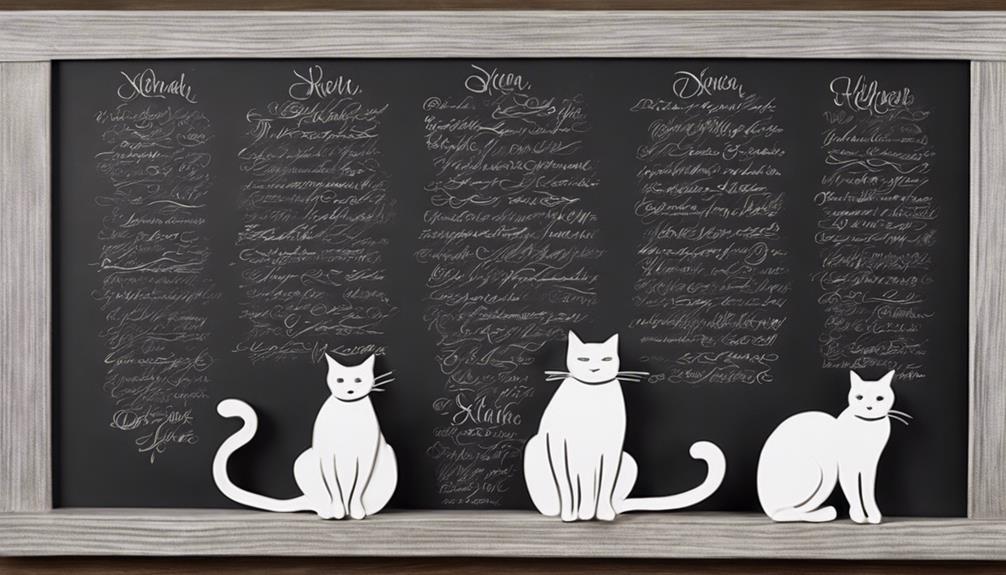
Looking for creative names for your black and white cat? Consider these 7 options to capture their uniqueness. 'Midnight Magic' evokes mystery and elegance. 'Tuxedo Twist' adds a stylish flare. 'Monochrome Muse' enhances the bond between you and your feline. 'Whisker Whirlwind' reflects their spirited nature. 'Ebony Echo' symbolizes their distinctive traits. 'Purrfect Yin-Yang' signifies harmony and balance. Finally, 'Inkwell Illusion' captures their sophistication. These names showcase your cat's charm and personality beautifully. Trust us, there's more to discover in giving your black and white cat the perfect name.
Key Takeaways
- Midnight Magic: Represents mysterious allure and elegance in a black and white cat's name.
- Tuxedo Twist: Offers a stylish and fun naming option with a touch of creativity.
- Monochrome Muse: Enhances the bond between owner and pet with unique names.
- Whisker Whirlwind: Captures the lively spirit and dynamic personality of the cat.
- Ebony Echo: Reflects the sleek black coat and mysterious charm of black and white cats.
Midnight Magic

Let's explore why Midnight Magic is a perfect match for your black and white cat. This imaginative name is like a spell that embodies the mysterious allure and enchanting aura of Black and White Cats.
Imagine calling out 'Midnight Magic' and watching as your feline friend gracefully appears, embodying the elegance and charm that this name exudes. It's not just a name; it's a symbol of the mesmerizing contrast between the dark of midnight and the magical essence of your unique cat's coloring.
Choosing Midnight Magic for your Black and White Cat adds a touch of sophistication and intrigue to their identity. It's a name that not only sounds enchanting but also perfectly captures the beauty and charm of these special felines. When you opt for Midnight Magic, you're giving your cat a name that stands out and leaves a lasting impression on everyone they meet.
Embrace the magic of Midnight Magic and watch as your black and white cat enchants all who cross their path.
Tuxedo Twist

Tuxedo Twist offers a fresh and creative take on naming your black-and-white feline friend. This moniker isn't only stylish but also hints at the cat's formal appearance with a twist of fun.
When considering names for your tuxedo cat, keep in mind the inspiration behind the name, how it reflects their personality, and the uniqueness it brings to their identity.
Name Inspiration Ideas
Incorporating the Tuxedo Twist theme into your naming process can infuse your black-and-white cat's identity with a touch of elegance and charm. Black-and-white themed names like Tux, Tuxie, or even Tuxedo itself can perfectly suit your feline friend's formal appearance.
These names capture the essence of sophistication, highlighting your cat's stylish white chest in a playful manner. The Tuxedo Twist theme adds a unique flair to your cat's persona, emphasizing their dapper and refined look.
Choosing a name from this theme not only celebrates your cat's coloring but also showcases their classy demeanor. Let the Tuxedo Twist inspire you to find the perfect name that complements your elegant black-and-white companion.
Personality Match Suggestions
Exploring personality match suggestions for black and white cats, like those inspired by the Tuxedo Twist theme, can help highlight your feline friend's unique traits and characteristics.
- Matching your cat's name to its personality fosters a special bond.
- Tuxedo Twist names add a playful element to your cat's identity.
- Consider names reflecting sophistication and elegance.
- Tailoring the name to your cat's charm can bring out its distinctive qualities.
Unique Moniker Options
Considering the distinctive coloring and charming characteristics of your black-and-white cat, there are numerous creative moniker options that can perfectly capture their unique identity.
Tuxedo Twist offers a fun way to name your feline friend with a tuxedo-like appearance and a vibrant personality. Names like Domino, Zorro, and Checkers showcase the creativity in highlighting your cat's black-and-white coat.
Opting for a Tuxedo Twist name can add a touch of whimsy and individuality to your pet's identity. Embracing these moniker options not only reflects your cat's appearance but also celebrates their charming traits.
Choosing a name that resonates with your cat's black-and-white beauty can make the naming process a memorable and enjoyable experience for both you and your feline companion.
Monochrome Muse
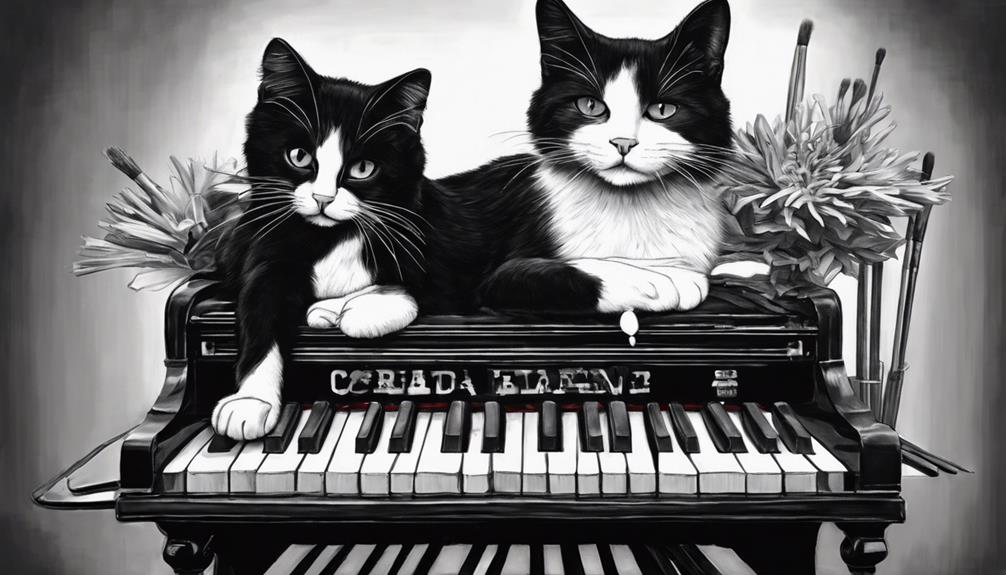
Monochrome Muse offers a curated selection of creative and unique names tailored specifically for black and white cats, capturing their essence and personality. These names are inspired by the distinct coloring and patterns of black and white felines, aiming to provide you with the perfect moniker for your beloved pet.
Here are some key features of the names provided by Monochrome Muse:
- Each name suggestion reflects the charm and individuality of black and white cats.
- The curated list enhances the bond between you and your pet by adding a special touch to your cat's identity.
- These names are carefully crafted to bring out the unique traits and characteristics of your black and white cat.
- Monochrome Muse's creative names can help you express your cat's white and black beauty in an unforgettable way.
Whisker Whirlwind

Upon meeting a lively black-and-white cat with distinctive whiskers, 'Whisker Whirlwind' instantly becomes a fitting and unforgettable name choice. This creative name idea perfectly captures the essence of your new black-and-white cat, adding a touch of whimsy and energy to their identity.
Picture a playful feline whose whiskers seem to dance in the wind, embodying the spirit of a whirlwind with each graceful movement. By choosing 'Whisker Whirlwind' for your black cat, you not only highlight their physical feature but also showcase their spirited nature in a charming and unique way.
This name is more than just a label; it's a reflection of your cat's dynamic personality and a tribute to their lively demeanor. So, if you're looking to give your black-and-white cat a name that stands out and brings a sense of excitement, 'Whisker Whirlwind' is the perfect choice.
Ebony Echo

When considering a name for your black and white cat, Ebony Echo can be a striking choice that embodies their contrasting colors.
The name Ebony signifies the sleek black coat, while Echo adds a touch of mystery and allure.
Naming Inspiration Sources
Drawing on a tapestry of inspiration, names for black and white cats can be as diverse as their striking coats suggest.
- Cats with tuxedo effects can be named after iconic figures like Fred Astaire or Carey Grant.
- Names like Boots, Socks, or Chuck Taylor suit cats with contrasting feet.
- Cats with distinctive stripes or spots could be named Zebra or Domino.
- Movie character-inspired names like Cruella, Snoopy, or Matrix are great options for black-and-white cats.
Personality Traits Reflected
Exploring the distinctive personality traits of a black and white cat like Ebony Echo can offer insight into their unique charm and character. Ebony Echo, as a name, reflects the striking contrast in the cat's fur, showcasing a blend of elegance and mystery. This name is perfect for a new feline companion with a special charm. To help you understand how a name like Ebony Echo can capture the essence of your black and white cat, here are some personality traits that may be reflected:
| Personality Trait | Description |
|---|---|
| Playful | Loves games and toys |
| Mysterious | Enjoys exploring |
| Elegant | Graceful movements |
| Unique | One-of-a-kind behaviors |
Choosing a special name like Ebony Echo can truly highlight the individuality of your beloved pet.
Purrfect Yin-Yang
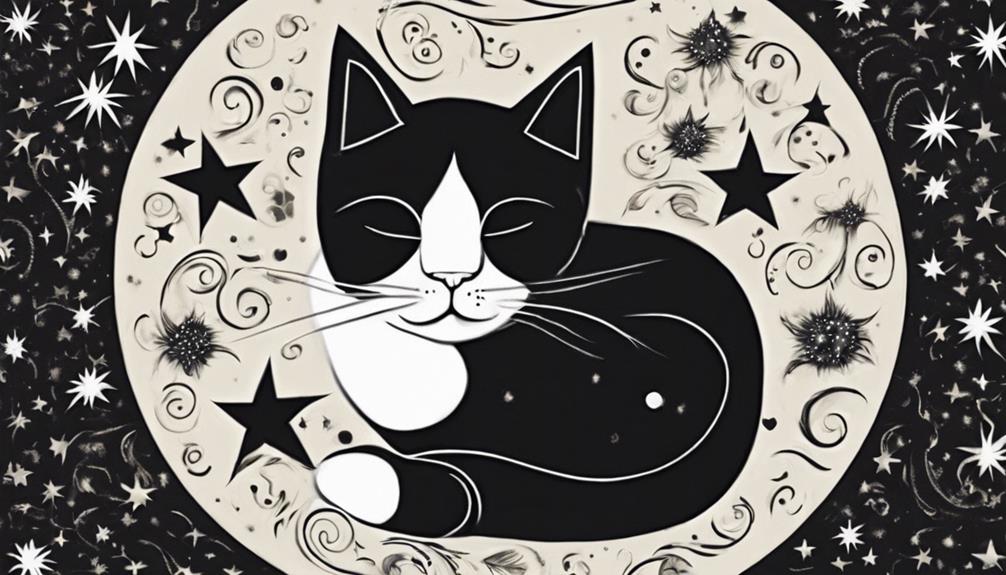
Symbolizing harmony and balance, Purrfect Yin-Yang is a creative and fitting name for a black and white cat. When contemplating a name for your new feline friend, it's crucial to select a name that resonates with their unique characteristics. Here are some reasons why Purrfect Yin-Yang could be the purrfect choice:
- Inspired Symbolism: The yin-yang symbol represents the balance of opposites, making it a meaningful choice for a cat with dual-toned fur.
- Reflecting Complementary Forces: Just like the contrasting colors in the yin-yang symbol, this name highlights the beauty of the black and white coat on your feline companion.
- Elegance and Mystique: Purrfect Yin-Yang adds a touch of elegance and mystique to your cat's identity, giving them a sophisticated aura.
- Balanced Personality: This name is ideal for a cat with a balanced personality, reflecting both playful energy and calm demeanor.
Choosing Purrfect Yin-Yang can't only be aesthetically pleasing but can also capture the essence of your black and white cat's unique charm.
Inkwell Illusion
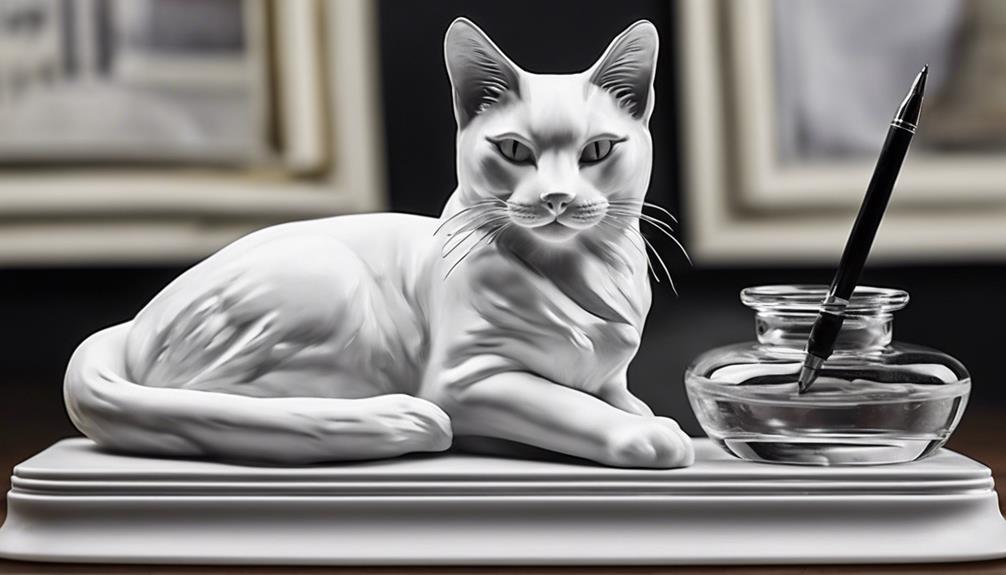
An intriguing name that beautifully captures the essence of your black and white cat is Inkwell Illusion. When welcoming a new feline into your family, choosing the right name is essential to reflect their unique traits. Inkwell Illusion stands out as one of the great White Cat Names for your pet.
The combination of dark ink represented by 'Inkwell' and the contrasting white portrayed by 'Illusion' creates a mesmerizing image that mirrors your cat's coat. This name not only sounds elegant but also adds a touch of sophistication to your furry friend's identity.
Imagine calling out 'Inkwell Illusion, come here!' It rolls off the tongue smoothly, establishing a bond between you and your cat. Your family will appreciate the creativity and imagination behind this name, showcasing the beauty of your black and white cat's distinctive coloring.
Embrace the allure of Inkwell Illusion as it symbolizes the mysterious charm of your beloved pet.
Frequently Asked Questions
What Is a Fun Name for a Black and White Cat?
We love choosing fun names for black and white cats! How about Oreo, Panda, Patches, Marbles, Pixel, Domino, or Zorro? These names capture the playful and charming essence of our feline friends. Let's make our cat's identity pop!
What Do You Call a Black and White Cat?
We call a black and white cat by various names like 'tuxedo cats,' 'cow cats,' or 'magpie cats.' These feline friends are also known as 'Oreo cats' or simply black and white cats. Their unique coat patterns inspire creative monikers.
What Are the 100 Names of Cat?
We've compiled 100 unique cat names, covering various themes like nature and history. Each name reflects a different vibe, from classic to trendy, ensuring you find the perfect fit for your black and white feline friend.
What Are Unique Cat Names?
When it comes to unique cat names, we love getting creative! From whimsical picks to unconventional choices, selecting a special name for your black-and-white feline friend can truly show off their individuality and charm.
Conclusion
To sum up, naming your black and white cat can be a fun and creative process. Whether you choose Midnight Magic, Tuxedo Twist, or any of the other unique names mentioned, remember that the name you pick should reflect your cat's personality and charm.
So, take your time and find the purrfect name that suits your feline friend to a T. After all, a cat with a great name is like a stroke of artistic genius on a canvas of fur.
Paul’s love for animals knows no bounds. As a dedicated writer and animal lover, Paul brings a unique perspective to our team. His firsthand experiences with various animals enrich our content and provide valuable insights into their behavior and needs. Whether he’s sharing tips for pet care or shedding light on pressing conservation issues, Paul’s passion for animals shines through in everything he does.
Cats
How Small Are Calico Cats?
Intrigued by calico cats' size? Discover the charming weight ranges of small and medium calicos, from 7 to 12 pounds.

Calico cats, with their charming tri-color coats, come in small and medium sizes. Smaller calicos typically weigh around 7 to 9 pounds, while medium-sized ones can reach up to 12 pounds. Size variations result from genetics and breed influences. They start tiny as kittens, doubling their weight within a couple of weeks. Healthy growth leads them to around 1-2 pounds by 6-8 weeks old. Factors like diet and exercise play key roles in their development. Understanding their weight and length helps categorize their size accurately. More intriguing details await in the fascinating world of calico cats!
Key Takeaways
- Calico cats can vary in size, with small ones typically weighing around 5 to 8 pounds.
- Genetic factors and breed influence the size of calico cats.
- Proper care for small calico cats includes gentle handling and tailored attention.
- Small calico cats may require adjustments in diet and exercise for optimal health.
- Despite their size, small calico cats exhibit the same vibrant tri-color coat patterns.
Average Size of Calico Cats
On average, calico cats weigh up to 12 pounds and measure around 18 inches from head to tail. The size of calico cats can vary depending on their breed. Some breeds may be smaller or larger than the average size.
When it comes to calico kittens, they might start off small, but with proper care and nutrition, they can grow into medium to large-sized cats. It's fascinating to see how breed-specific characteristics play a role in determining the size of these beautiful felines.
Understanding the average size of calico cats can help us appreciate the uniqueness of each individual cat within this breed. Whether they're on the smaller or larger side of the spectrum, calico cats never fail to capture our hearts with their striking coat patterns and charming personalities.
Factors Affecting Calico Cat Size

Factors influencing the size of calico cats include their breed, genetics, diet, and exercise habits. Genetics play a significant role in determining the size of a calico cat, as certain breeds like the Maine Coon are known for being larger in stature. Providing a balanced diet is essential in maintaining a healthy weight for your calico feline friend. Regular exercise also plays a key role in ensuring that your cat stays active and maintains an ideal size. By incorporating these factors into your cat's lifestyle, you can help them achieve their best size and overall well-being.
| Factor | Influence | Importance |
|---|---|---|
| Genetics | Determines inherent size traits | High |
| Diet | Affects weight management | Moderate |
| Exercise | Maintains physical health | High |
Understanding how these factors interplay can guide you in supporting your calico cat's size goals effectively. Remember, a healthy cat is a happy cat!
Size Variations Among Calico Breeds
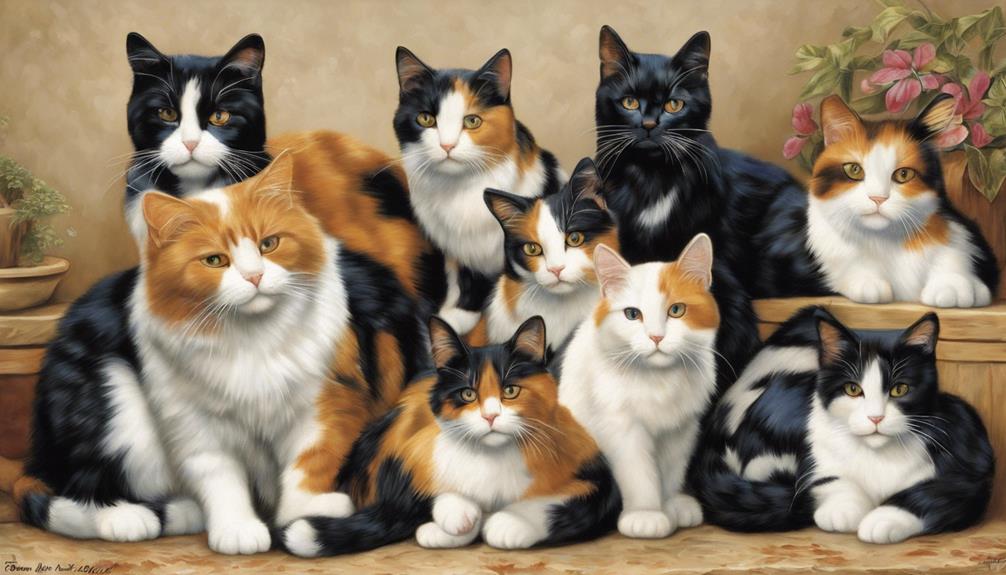
Calico cats come in various sizes depending on their breed. Some breeds are larger and heavier than others. Factors such as breed size differences and genetic influences play a role in determining the size of a calico cat.
Understanding these variations can provide valuable insights into the potential size and weight range of different calico breeds.
Breed Size Differences
Among different calico breeds, the size variations can range from small to large, influenced by their respective breed characteristics and genetic makeup. Breeds like the Japanese Bobtail tend to have smaller-sized calico cats, while larger breeds such as the Maine Coon are known as gentle giants, resulting in larger calicos.
The size of a calico cat is determined by a combination of genetics and individual growth patterns unique to each breed. Some calico cats may have a petite frame, while others might be more substantial in size. Understanding the breed's typical size range can help anticipate how big a calico cat might grow.
Keep in mind that factors like diet and exercise also play a role in a cat's overall size and weight.
Genetic Factors Influencing Size
Influential genetic markers greatly impact the size variations observed among different calico breeds. These genetic factors play a vital role in determining the size of calico cats as they grow and develop.
Depending on the breed, calico cats can vary considerably in size. For instance, breeds like Maine Coons tend to be larger compared to smaller breeds like Turkish Angoras. The average weight of a calico cat typically falls between 8 to 12 pounds, but some breeds may weigh more or less.
Size variations among calico breeds not only affect their physical appearance but also contribute to their unique characteristics. Understanding the genetic influences on size can provide insights into the development and traits of calico cats across different breeds.
Growth Stages of Calico Kittens
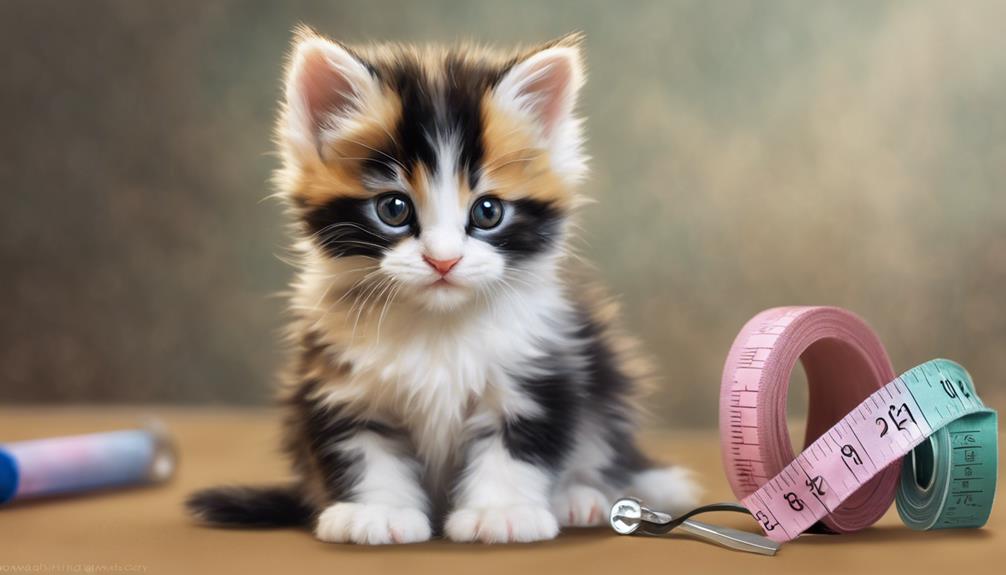
During the growth stages of calico kittens, their weight can increase substantially within a few weeks. It's fascinating to witness these adorable furballs transform and grow rapidly.
Here are some key points to bear in mind:
- Calico kittens are typically born weighing around 3-4 ounces.
- At 2 weeks old, calico kittens may double their birth weight.
- By 6-8 weeks, calico kittens can weigh between 1-2 pounds.
- These fluffy creatures reach adulthood around 9-12 months old.
- Adult female calico cats can weigh between 7-12 pounds.
Watching calico kittens go through these growth stages is like observing nature's magic in action. From tiny newborns to playful juveniles, their journey to adulthood is filled with wonder. As they gain weight and develop, their unique color patterns become more pronounced, adding to their charm. It's truly a joy to witness these precious beings grow into beautiful adult calico cats.
Determining Small Vs. Medium Calico Cats
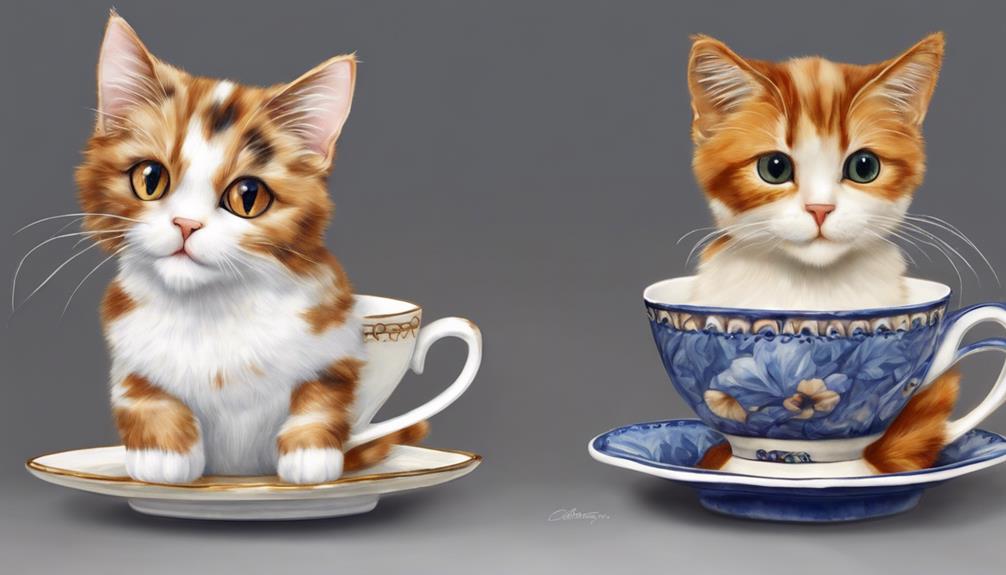
As we explore the sizes of calico cats, it becomes apparent that determining whether a calico cat is small or medium hinges on factors such as weight and length. Medium calico cats typically weigh up to 12 pounds, while small ones may range around 7-9 pounds. Additionally, the genetics and specific breed of the calico cat play a role in determining its size. Calico kittens, like most kittens, start small and gradually grow into their medium size as they mature. Understanding the average weight and length of calico cats can help in categorizing them as small or medium.
| Size | Weight | Length |
|---|---|---|
| Small | 7-9 pounds | Varied |
| Medium | Up to 12 pounds | Varied |
| Large | Over 12 pounds | Varied |
Comparing Calico Cats to Other Breeds

Comparing calico cats alongside different breeds reveals distinctive size differences influenced by breed characteristics and genetic diversity. When examining calico cats alongside various breeds, it becomes evident that size variations exist due to a combination of factors. Here are some key points to ponder:
- Calico cats can range from small to medium-sized based on their breed.
- Genetic diversity plays a significant role in determining the size of calico cats.
- Some breeds, like the Maine Coon, tend to be larger than others, contributing to the size differences observed.
- While calico cats may generally fall within the small to medium-sized category, individual variations within breeds are common.
- Size in calico cats isn't solely dependent on coat color but is also influenced by breed-specific characteristics and overall genetics.
Understanding how calico cats compare to other breeds regarding size provides valuable insight into the diverse world of feline companions.
Size Considerations for Calico Cat Care

When tending to a calico cat, it's vital to take into account their size to provide proper care and guarantee their well-being. Calico cats can vary in size depending on their breed, with some being small to medium-sized. The average weight of a calico cat typically ranges from 8 to 12 pounds, but smaller calico cats may weigh around 5 to 8 pounds, while larger breeds can reach up to 15 pounds.
Understanding the size of your calico cat is essential for providing appropriate care, including feeding the right food portions and making sure they've a suitable living space. It's important to contemplate their size when selecting toys and accessories to ensure they're comfortable and engaged. By being mindful of the size and weight of your calico cat, you can tailor their care to meet their specific needs and promote a healthy, happy life for your feline companion.
Tips for Handling Small Calico Cats
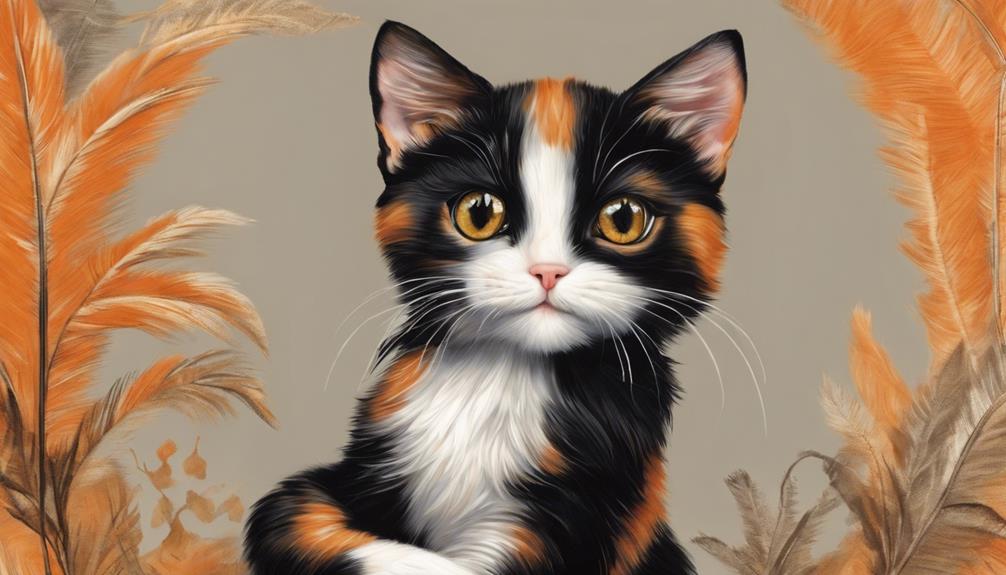
When handling small calico cats, it's important to be gentle and considerate of their size and potential fragility. Supporting their bodies properly and avoiding sudden movements can help prevent any accidental injuries.
Remember to approach them calmly and give them time to adjust to your touch.
Calico Cat Care
Handling small calico cats involves ensuring proper body support to prevent injuries and maintain their health and well-being. When caring for these adorable felines, consider the following tips:
- Regular Grooming: Brush their coat to prevent matting and reduce shedding.
- Interactive Play: Engage in play sessions to satisfy their playful nature and keep them active.
- Nutritious Diet: Provide a balanced diet suitable for their size and activity level.
- Safe Environment: Create a secure space with no small objects they could ingest.
- Veterinary Check-ups: Schedule regular check-ups to monitor their health and address any concerns promptly.
Behavior and Training
To effectively nurture the behavior and training of small Calico cats, engaging in positive reinforcement techniques is key to fostering a strong bond and encouraging good habits. Interactive play sessions and providing vertical spaces for climbing can help keep these petite felines active and mentally stimulated. Behavioral training tailored to their size can aid in establishing routines and boundaries. Check out the table below for quick tips on handling small Calico cats:
| Training Tips | Description |
|---|---|
| Positive Reinforcement | Reward good behavior with treats and praise |
| Interactive Play Sessions | Engage in playtime to keep them active |
| Vertical Spaces | Provide cat trees or shelves for climbing |
Calico Cat Weight Ranges

How much can calico cats typically weigh, and what factors influence their weight range?
Calico cats can vary in weight, ranging from 5 to 12 pounds depending on factors such as breed, individual size, and lifestyle choices like diet and exercise.
Here are some key points to contemplate:
- Calico cats can weigh anywhere from 5 to 12 pounds, with smaller breeds like the Japanese Bobtail typically weighing around 5 to 9 pounds.
- Larger breeds such as the Maine Coon can reach weights of up to 12 pounds.
- Weight ranges for calico cats may be influenced by their diet, exercise levels, and overall health.
- Regular monitoring of your calico cat's weight is essential to guarantee they maintain a healthy size and body condition.
- Consulting with a veterinarian can help determine the ideal weight range for your specific calico cat based on their breed and individual characteristics.
Understanding and managing your calico cat's weight can contribute to their overall health and well-being.
Notable Physical Features of Calico Cats
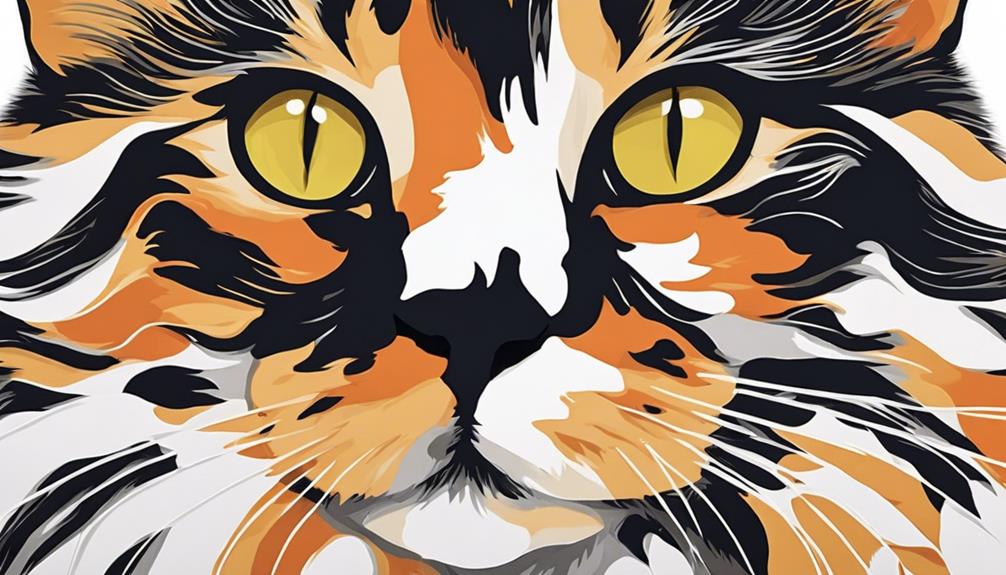
Calico cats are recognized for their colorful coat patterns, with a mix of white, black, and orange hues creating a unique and eye-catching appearance.
These felines are mainly female due to the genetics behind their distinctive coat coloring.
The genetic uniqueness in their coloring makes calico cats stand out as visually striking companions.
Colorful Coat Patterns
Exhibiting a unique tri-color coat pattern, calico cats showcase a blend of white, black, and orange patches that make them easily distinguishable among feline breeds.
These colorful coat patterns aren't limited to a specific breed but can be found in various cats.
The distinct coat of calico cats is determined by genetic factors associated with the X chromosome.
Calico cats may also display additional colors like diluted or tabby markings, adding to their vibrant appearance.
Remarkably, male calico cats are rare due to the genetic basis of their tri-color coat, which is why calico cats are primarily female.
Their stunning coats truly make calico cats stand out in the world of felines.
Females Predominantly Found
Mainly seen among calico cats are females, displaying their unique genetics through their distinct tri-color coat patterns. These females showcase a blend of white, black, and orange hues that create a striking visual appearance. Despite their small to medium-sized stature, calico cats exude vibrant personalities that make them stand out in any household.
Their affectionate nature and playful demeanor add charm to their already eye-catching physical features. The tri-color coat pattern not only sets them apart from other cat breeds but also serves as a beautiful canvas to highlight their fun-loving and lively character. It's no wonder that calico cats, especially the females, capture the hearts of many with their unique combination of genetic traits and engaging personalities.
Genetic Uniqueness in Coloring
In observing the genetic uniqueness of calico cats' coloring, one can appreciate the intricate interplay of X chromosome inactivation during embryonic development.
- The tri-color coat pattern of white, black, and orange is a result of specific genetic traits.
- X chromosome inactivation leads to the distinct coloration seen in calico cats.
- Their mottled appearance is created by randomly distributed patches of color on their coat.
- Variations in coat patterns can include tabby markings or diluted colors alongside the tri-color scheme.
- The genetic complexity behind calico coloring not only makes these cats visually striking but also highly sought after for their aesthetic appeal.
Health Implications of Small Size
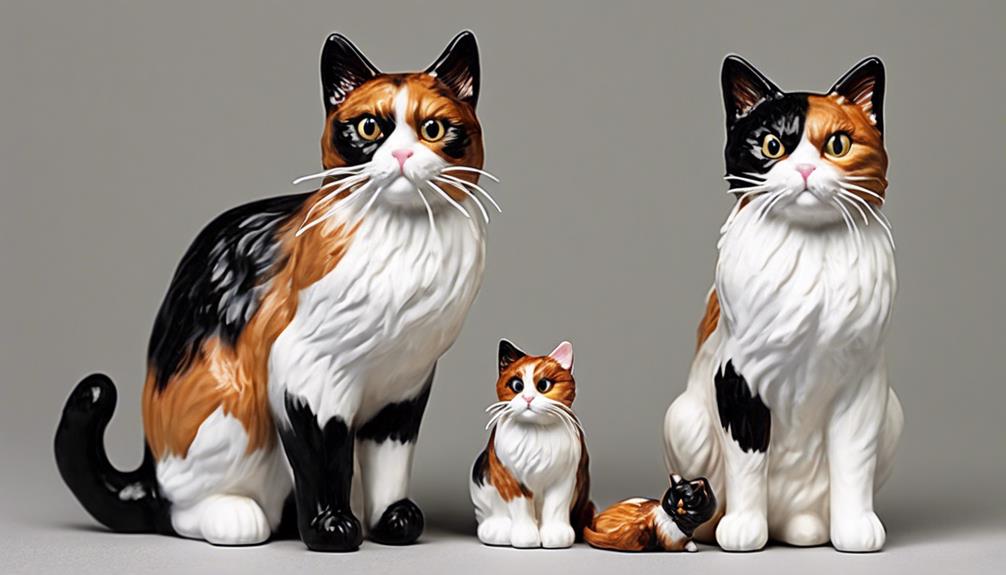
When considering the health implications of small size in calico cats, it's important to understand that individual genetics and breed greatly influence their stature.
While calico cats can vary in size, typically weighing between 8 to 12 pounds for females and slightly larger for males, being small doesn't necessarily indicate health issues. Regular vet check-ups are vital to monitor their growth and guarantee they maintain a healthy weight.
Proper nutrition and exercise play key roles in maintaining the health and size of a calico cat. Despite potentially being smaller compared to other breeds, with the right care, they can lead healthy and active lives.
Nutritional Needs for Small Calico Cats

Small Calico cats have specific nutritional needs that must be met to guarantee their health and well-being. Ensuring a diet high in protein is vital for their energy and muscle development.
Consulting a veterinarian for tailored dietary recommendations based on breed and activity level is essential for small Calico cats.
Calico Cat Diet
To optimize the health and energy of small calico cats, prioritizing their dietary needs is essential. When it comes to the diet of small calico cats, here are some key points to keep in mind:
- Balanced Diet: Small calico cats require a well-rounded diet to meet their nutritional needs adequately.
- Protein Intake: High-quality protein is important for muscle maintenance and growth in their petite bodies.
- Portion Control: Smaller portion sizes may be beneficial for small calico cats to maintain a healthy weight and prevent obesity.
- Essential Nutrients: Providing a diet rich in essential nutrients such as vitamins, minerals, and omega-3 fatty acids is crucial for their overall health.
- Hydration: Ensuring they've access to fresh water at all times is necessary for their well-being.
Protein Requirements
Supporting the growth and development of small calico cats, a high-quality protein-rich diet is important to guarantee their muscle health and overall well-being. Protein requirements for small calico cats are essential for muscle growth, repair, and overall health. Ensuring they receive adequate protein intake is key to maintaining a strong immune system and promoting best well-being.
Specially formulated kitten food with higher protein content can be beneficial for small calico cats to meet their nutritional needs. Opting for protein sources like chicken, fish, or turkey can provide these kitties with essential amino acids necessary for their overall health. By prioritizing their protein requirements, we can help small calico cats thrive and lead active, healthy lives.
Special Dietary Considerations
Considering the unique dietary needs of small calico cats, a focus on providing nutrient-dense foods tailored to their growth and development is paramount.
- Small size requires adjusted portion sizes for weight management and energy levels.
- Nutrient-dense food, especially high-quality kitten food, supports their growth.
- Establish a proper feeding schedule to meet their dietary requirements.
- Consult a veterinarian to determine the best diet and feeding plan.
- Monitor food intake and guarantee access to fresh water for their well-being.
Exercise Requirements for Calico Cats
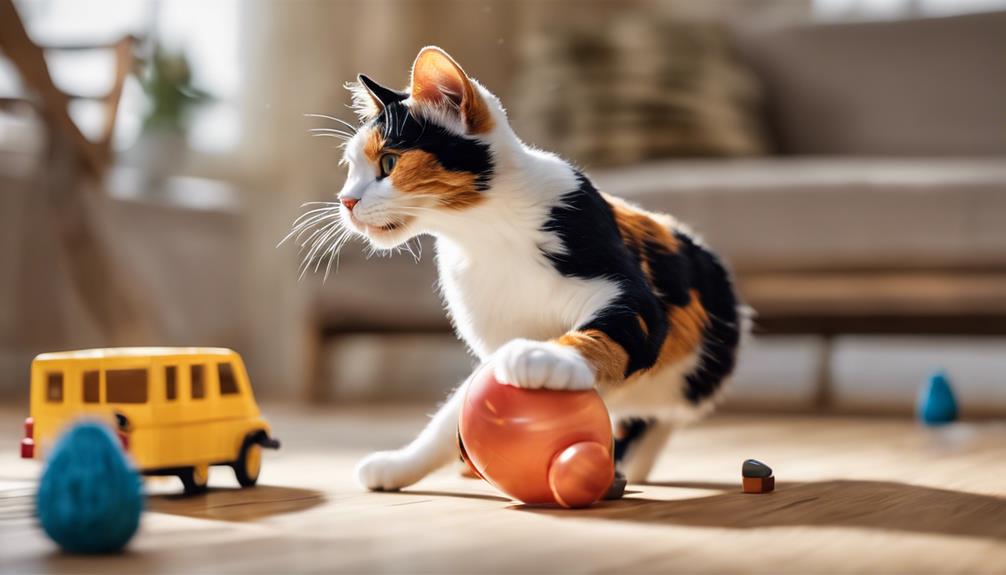
Calico cats of all sizes benefit from engaging in regular exercise to maintain their health and happiness. Meeting the exercise requirements of your calico cat is vital for their overall well-being. Interactive toys and climbing structures can provide both physical and mental stimulation, keeping your feline friend entertained and active. Play sessions are also essential for calico cats, as they enjoy engaging with their human companions in fun activities. Indoor play options like laser pointers or feather toys can be great for calico cats living in limited spaces, ensuring they get the exercise they need.
Regular exercise not only prevents obesity but also promotes a healthy lifestyle for your calico cat. By incorporating playtime into their daily routine, you can help them stay active and happy. Remember, a happy cat is a healthy cat, so make sure to prioritize their exercise needs to keep them thriving.
Small Calico Cats in Multi-Pet Homes
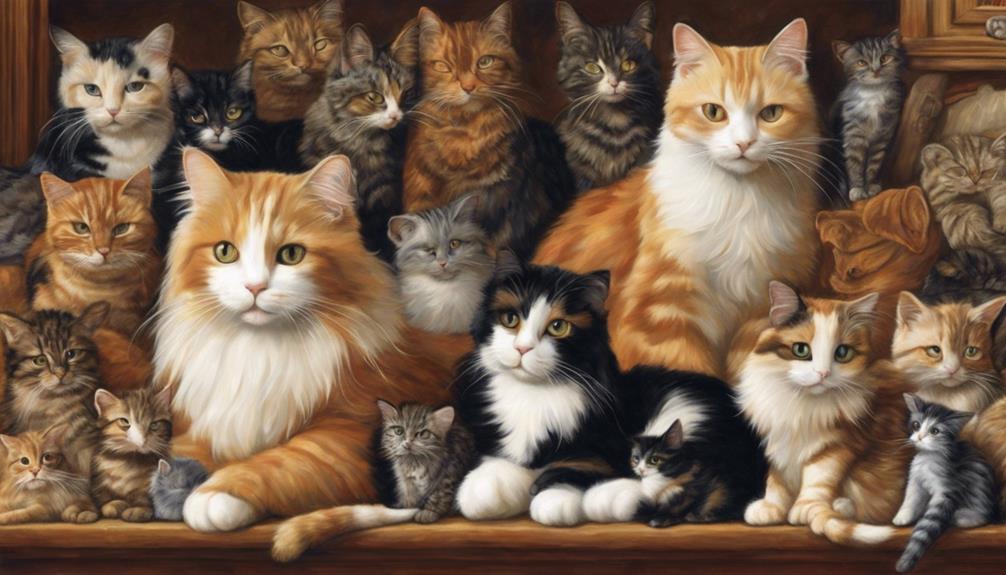
Small calico cats in multi-pet homes adapt well to their surroundings with proper introductions and socialization. These petite felines bring charm and warmth to a household, regardless of their size. Here are some key points to ponder when welcoming a small calico cat into a multi-pet environment:
- Size doesn't diminish their vibrant tri-color coat patterns.
- Introductions should be gradual to allow for adjustment.
- Socialization is essential for their well-being and confidence.
- Providing vertical spaces for climbing can enrich their environment.
- Creating a safe and comfortable space promotes harmony among pets.
When integrating a small calico cat into a multi-pet home, patience and understanding go a long way. These affectionate companions may be small in size, but their personalities shine brightly in a loving and inclusive setting. By fostering positive interactions and meeting their unique needs, small calico cats can thrive alongside other pets, adding joy and companionship to the household.
Conclusion: Embracing Calico Cats of All Sizes
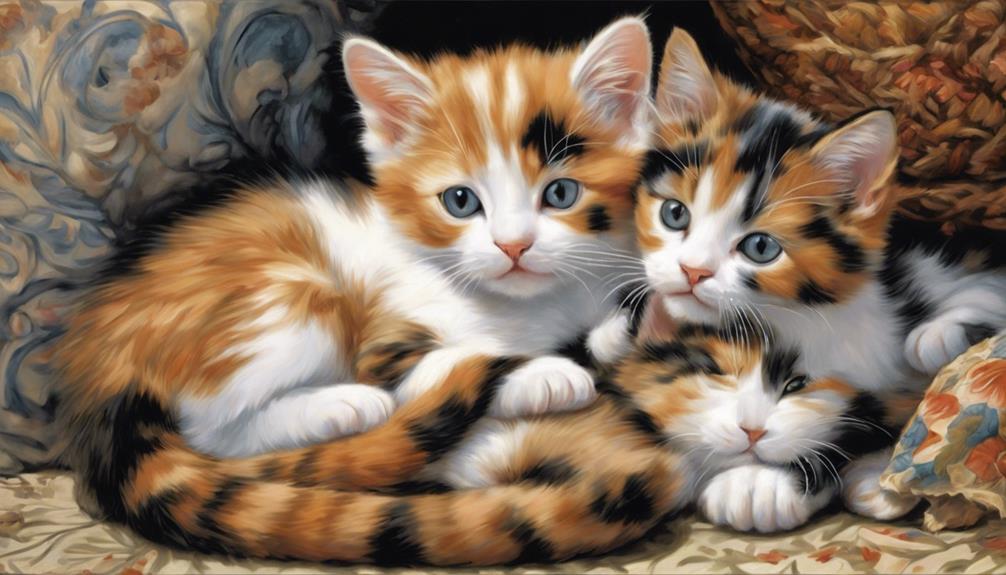
In our homes, diversity in the sizes of calico cats offers a delightful range of companionship and charm. From the dainty 6-8 pound petite calicos to the hefty 12-18 pound Maine Coon mixes, each cat brings its unique size and personality to our lives. The variation in size isn't just about aesthetics; it's influenced by genetics, breed, and the cat's individual health and lifestyle. As calico kittens grow, their sizes may surprise us, reflecting their specific breed characteristics.
Understanding your calico cat's size and weight is important for their well-being. Monitoring their weight helps in providing appropriate care and ensuring they stay healthy. Embracing calico cats of all sizes means appreciating the beauty and diversity they bring into our homes. Whether your calico cat is small and delicate or large and imposing, each size comes with its own set of charms and joys. So let's celebrate the uniqueness of every calico cat, regardless of their size.
Frequently Asked Questions
Why Is My Calico Cat so Small?
We noticed our calico cat's petite size and wondered, "Why is my calico cat so small?" Factors like genetics, diet, and health play a role. Regular vet check-ups help monitor growth. Providing balanced nutrition and exercise is key for their well-being.
What Breed Is a Small Calico Cat?
We've found that small Calico cats can come in various breeds, like Japanese Bobtail or Singapura. Their size typically ranges from 5 to 10 pounds, influenced by genetics, care, and breed characteristics.
Are Calico Cats Really Cuddly?
Yes, calico cats are really cuddly. They seek physical contact, purr, knead, and enjoy snuggling close. Their affectionate nature varies, but many love bonding through cuddles. Spending time together strengthens the bond between us.
Why Are Calico Cats so Special?
We adore calico cats for their enchanting tri-color coats and unique genetic makeup. Their rarity, almost exclusively female, adds to their allure. Calico cats symbolize luck and are visually striking, making them truly special.
Conclusion
To sum up, ensuring your calico cat, whether it's small, medium, or somewhere in between, receives the appropriate care and attention they require to thrive is crucial.
Remember, size isn't a factor when it comes to the affection and companionship these vibrant felines bring into our lives.
Embrace your calico cat, regardless of how petite or plump they may be, and cherish the unique bond you share with your purrfect companion.
Paul’s love for animals knows no bounds. As a dedicated writer and animal lover, Paul brings a unique perspective to our team. His firsthand experiences with various animals enrich our content and provide valuable insights into their behavior and needs. Whether he’s sharing tips for pet care or shedding light on pressing conservation issues, Paul’s passion for animals shines through in everything he does.
-

 Vetted2 months ago
Vetted2 months ago15 Best Cat Foods for Managing Hyperthyroidism – Vet Approved and Feline Friendly
-

 Vetted2 months ago
Vetted2 months ago15 Best Dog Foods for Kidney Disease – Expert Recommendations for Your Pet's Health
-

 Vetted2 months ago
Vetted2 months ago15 Best Fresh Dog Food Delivery Services for Your Pup's Health and Happiness
-

 Animal Facts2 months ago
Animal Facts2 months agoSpring Animals: A Guide to Seasonal Wildlife
-
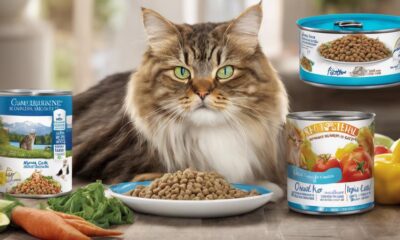
 Vetted2 months ago
Vetted2 months ago15 Best Wet Cat Foods for Older Cats to Keep Them Healthy and Happy
-

 Cats7 days ago
Cats7 days agoTop 5 Cat Breeders in Arkansas: A Guide
-

 Cats1 month ago
Cats1 month agoCat Weight Chart by Age: Kitten to Senior in Lbs
-

 Rabbits2 months ago
Rabbits2 months agoExploring Rabbit Holes: What Do They Look Like?



















